
More Recent Fishing Reports
Follow on X • Follow on Facebook • L.O.W 6-4 • Ely MN 6-4 • Sundin 6-3 • Sundin 6-2 • Dick and Paul 5-31 • Mushy Crappies 5-30 • Night Walleyes 5-26 • Lake Winnie 5-25 • Crappies 5-23 • Sundin 5-20 • Winnie-Cutfoot 5-19 • Lake Winnie Season Outlook • Radomski On Walleye Limits • Don't Land A Citation 5-1 • 200 • Sundin 02-24 • MN DNR Rule Changes 02-13 • MN Hall of Fame 01-24 • Charts 1-23-25 • MAPS 1-22-23 • Upper Red Lake 12-8 • Barotrauma Study 1-25-24 • Fish Consumption • Forward Sonar • Panfish Workgroup
 May 31, 2025 "Fun With Dick and Paul, 2025 Spring Session"
May 31, 2025 "Fun With Dick and Paul, 2025 Spring Session"
Well, here we are again, “Fun with Dick and Paul” 2025 spring session. So, while I don’t typically write much on Saturday mornings, here’s a brief update about yesterday’s start to Dick and Paul’s 5 day fishing trip.
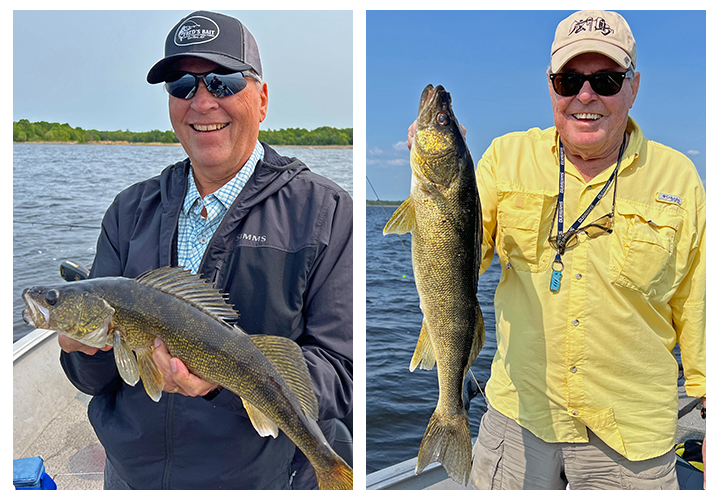 Fishing, as the photo reveals, was pretty fun. Getting on and off the lake though, that was another story. Low water levels plague many of the Itasca area’s river-fed lakes, especially those that have expansive shallow flats. What I’ve learned lately is that if there’s a way for water to escape, it has escaped.
Fishing, as the photo reveals, was pretty fun. Getting on and off the lake though, that was another story. Low water levels plague many of the Itasca area’s river-fed lakes, especially those that have expansive shallow flats. What I’ve learned lately is that if there’s a way for water to escape, it has escaped.
The lake we fished yesterday has 4 boat landings, 3 of them are completely un-accessible and the 4th, usable, but just barely. So, we used it, rolling my Alaskan off of the trailer wasn’t bad, and we were able to sneak across the shallow mud to get out to open water. Getting back on the trailer at days end was tricker, I had to get into the water to muscle the boat back up using the winch. From here on out, I’m planning to steer clear of the shallower lakes until we receive some rain. After that, I’ll keep you posted about conditions as they improve.
If your favorite fishing lake is shallow, has one or more river outlets, and is located in north central Minnesota, call one of the local resorts or bait shops for a report about the landings.
Yesterday’s fishing report wasn’t complicated; we fished shallow shoreline breaks in water depths of 6 to 12 feet. For me, there wasn’t any sweet spot, a mix of walleye, northern pike and perch were spread horizontally along the breaks. At times, we’d have a decent drift through an area, and I’d run back up for a 2nd pass. Seldom did we find enough fish to make that strategy worthwhile. By early afternoon, I’d resigned myself to spot-hopping, catching what we could on 1 pass, and then moving along to fresh territory.
Surface temperatures on the shallow, dark water lake ranged from 61 to 63 degrees. We spied on some of the local cabin owners checking the shallow water for panfish. We looked at some other shallow crappie spawning areas too, but didn’t find anything going on up there. The one crappie we did catch came out of about 10 feet of water, from the breakline adjacent to one of those shallow bulrush flats. That squares with reports that some of my friends have shared with me, most panfish are near their spawning grounds, but haven’t established residency in them. More about panfish as my spring session of Fun with Dick and Paul rolls on.
Ordinarily, we’d spend at least one day on Lake Winnie, but this year I don’t think we’ll do that. The ultra-clear water isn’t great for our “style” of fishing and friends report to me that walleyes on the big pond have been flighty, and more boat shy than usual. So, I’ll take advantage of my opportunity to roam the area and try out some fresh territory. Today, we’ll try one of the smaller lakes that treated us well last spring, and tomorrow, I’ll let you know how the excursion goes.
In the meantime, if you know something about a shallow water fishing lake in your region, help out your fellow anglers. Let us know if one, or more of the north central Minnesota lakes in your neighborhood has been hard to access. Reports from local resorts, bait shops and AIS inspectors are more than welcome here too, don't be shy. ![]() — Jeff Sundin, The Early Bird Fishing Guide Office Cell Call or Text 218-245-9858 or Email on Facebook on X
— Jeff Sundin, The Early Bird Fishing Guide Office Cell Call or Text 218-245-9858 or Email on Facebook on X
 Wired2Fish May 31, 2025 "[VIDEO] Premium Electronics Mounts: Beatdown Outdoors Walk-Through"
Wired2Fish May 31, 2025 "[VIDEO] Premium Electronics Mounts: Beatdown Outdoors Walk-Through"
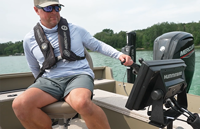 "In this video, Ryan DeChaine walks through how he upgraded his fishing boat using innovative mounting solutions from Beatdown Outdoors. The focus? Total flexibility, rock-solid rigidity, and unmatched accessibility—for any angler, in any position.
"In this video, Ryan DeChaine walks through how he upgraded his fishing boat using innovative mounting solutions from Beatdown Outdoors. The focus? Total flexibility, rock-solid rigidity, and unmatched accessibility—for any angler, in any position.
Every mount in this build prioritizes adjustability. Beatdown Outdoors offers mounts that rotate, tilt, raise, and lower effortlessly, letting you fine-tune your electronics to match how and where you fish. Whether standing at the bow or seated at the stern, these mounts make it easy to find the ideal viewing angle. You can bring displays closer, shift them out of the way, or set them at just the right height—without tools or hassle. That flexibility means fewer compromises and a better fishing experience for everyone on board.
Rigid Performance That Lasts: While the setup is flexible, the structure is ..." View Video and Learn More >> [VIDEO] Premium Electronics Mounts: Beatdown Outdoors Walk-Through
 May 30, 2025 Jeff Sundin's Panfish Recipes Section: How to Avoid Mushy Tasting Crappies
May 30, 2025 Jeff Sundin's Panfish Recipes Section: How to Avoid Mushy Tasting Crappies
 "Most freshwater fish have delicate, mild-tasting and flaky flesh, that's what people love about them. Some of the freshwater species though, are so delicate that cooking them may require special attention. The Crappie is one fish that benefits from a little special pre-cooking handling and care. Jeff Sundin shares some tips about how to avoid cooking "mushy" tasting crappie fillets with a reader who asked for advice.
"Most freshwater fish have delicate, mild-tasting and flaky flesh, that's what people love about them. Some of the freshwater species though, are so delicate that cooking them may require special attention. The Crappie is one fish that benefits from a little special pre-cooking handling and care. Jeff Sundin shares some tips about how to avoid cooking "mushy" tasting crappie fillets with a reader who asked for advice.
Yesterday, Adam Barett wrote. "We were up on Leech Lake for the Memorial weekend and on the last day we caught enough crappies for a meal. I cleaned them within a few hours and put them in the refrigerator. At home the next day, we had them for dinner. They were very mushy! Is this typical for spring crappies?
A) Adam, I actually have encountered mushy crappies in the past and have learned to ..." Read Full Story >> How to Avoid Mushy Tasting Crappies May 30, 2025
 May 29, 2025 "Noting the Note-Able"
Clear Water, Fish Location, Weekend Prospects and Angler Input Groups
May 29, 2025 "Noting the Note-Able"
Clear Water, Fish Location, Weekend Prospects and Angler Input Groups
LOST and FOUND: Location: Gosh Dam Place Fish Cleaning Station. Date: May 26-27, 2025
Did you or somebody you know leave something behind when cleaning fish at Gosh Dam Place this week? If so, I have it for safe keeping and would love to return it to its rightful owner. Shoot me a text, email or call me to let me know who you are, and we’ll work out the details for a safe return.
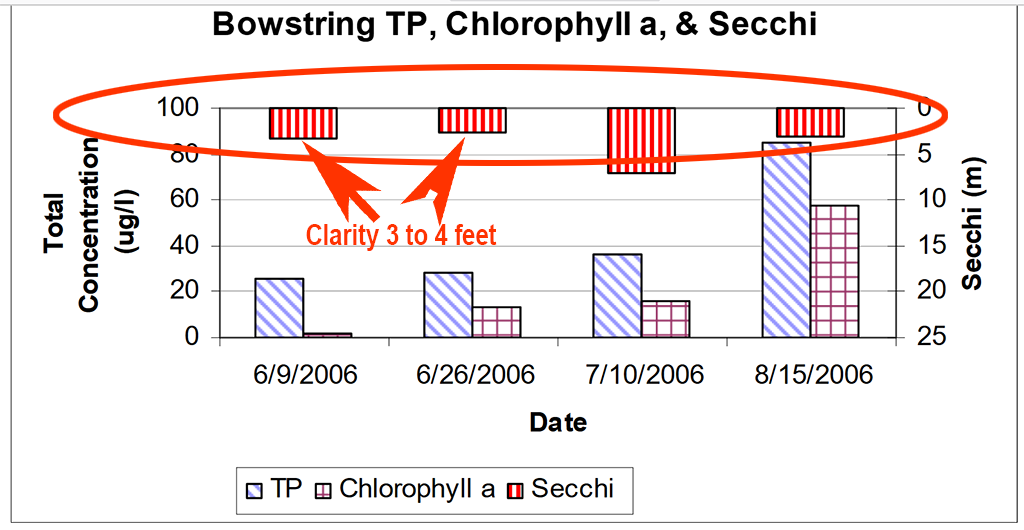 Low Water + Cool Weather + Zebra Mussels = Work Hard, and Smart, For Less. Water conditions in the Itasca Region are challenging in every way.
Low Water + Cool Weather + Zebra Mussels = Work Hard, and Smart, For Less. Water conditions in the Itasca Region are challenging in every way.
Boat landings on lakes with river outflows, like Bowstring, Round and others are extremely low. So, for starters, the challenge of catching fish, for many, starts with figuring out how to get a boat on the lake.
Without inflow from small rivers, feeder creeks and lowland drainage, some lakes are warming more slowly than they typically would. With surface water temperatures hovering in the low 60s, algae blooms have been minimal, and lacking drainage from low areas, there’s less “color” coming in from fertile flat lands. So, water clarity is high. On Bowstring Lake for example, we could easily see the bottom in water depths of 12 to 14 feet of water on Tuesday. Compared to the Bowstring Lake of 20 years ago, that’s an astronomical departure. Look at the Secchi disc readings from 2006, when water clarity was about 4 feet deep for June.
Yesterday, on Lake Winnie, the water was even clearer, over 20 feet for sure, maybe deeper.
I can’t say whether the increased clarity is either good or bad for the lakes. I just know that it makes life harder for an angler. Especially when coupled with calm, clear conditions like we’ve seen on certain days recently.
For me, catching fish was a game of hunting and pecking. Yesterday on Winnibigosh, we rarely stopped anyplace where we didn’t catch something, but we never stopped anyplace where we caught a lot of anything. The typical scenario was to sneak into a spot, make several casts, catch a couple of fish and then, when the action stopped, move along to the next location. Going deeper, or shallower didn’t matter either, whether fishing 22 feet, 12 feet, or 6 feet, the results were basically the same.
For me, the best presentation continues to be pitching and retrieving jigs tipped with live bait. Shiners, preferred by lots of anglers are working, but so are fatheads, or rainbows, when you can find the right sizes, 2-1/2 to 3 inches, are the best, I think. Plastic tails, like Berkeley’s Ripple Shads have begun producing some fish for me too. I can’t say that they’ve been better than minnows, but they’re holding their own. I caught a couple of nice walleyes, numerous perch and pike using them over the past couple days. I haven’t experimented with other brands, or tail designs, but I will do more over the next several days.
The brighter news is that we’re looking at an inbound warming trend. High temperatures in the 80s, more sunshine, and manageable winds should help warm the water, and advance fish migrations. Yesterday, we ran into some folks at the fish cleaning shack who had a nice setup of bluegills. “They’re just starting to move in toward spawning areas. We found them wandering over the shallow flats, and in some of the weed patches in the back bays,” the captain of their pontoon boat told us.
Crappies have already located in shallow water, and the weather forecast appears to favor them staying there. By this weekend, many of them will have already spawned, and should be found in cabbage patches located near, or adjacent to preferred spawning habitats.
Perch turned out to be the highlight of our fishing trip Tuesday. We found them in shallow, 5 to 7 feet deep water, wherever there were patches of cabbage weeds growing. We did a lot of sorting, but did manage to keep 34 fish in the 10-to-11-inch range. Warming water, along with breezy conditions might make this a good weekend to prowl for perch on one of your favorite lakes.
The MN DNR has announced the forming of 2 new citizen input groups. The Lake Winnibigoshish and Rainy Lake input groups will consist of people with a range of perspectives and experiences, including local fishing guides, local anglers, anglers from across Minnesota, local businesses and local resorts, and water-based businesses.
In their news release, the MN DNR advises, “The groups work closely with the DNR to provide input on fisheries management activities on these lakes, including any activities that are authorized, licensed, permitted, or otherwise regulated or managed by the state. Minnesotans can apply online through Tuesday, June 24, to serve on the fisheries input groups for Lake Winnibigoshish or Rainy Lake.
The DNR supports the groups by supplying information relevant to their discussions, including standard fish population assessments, creel (angler) surveys, status of invasive species, or other available information requested by the groups.
Detailed committee and application information for each group is available by clicking on the links here >>> Rainy Lake Page and the Lake Winnibigoshish page.
 Reader Comments May 28, 2025 "Angler Etiquette When Fishing"
Reader Comments May 28, 2025 "Angler Etiquette When Fishing"
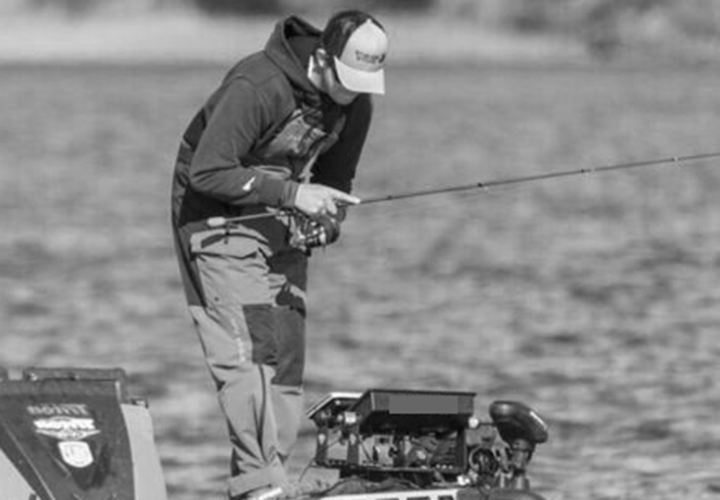 On Tuesday, May 27, 2025, Todd Martindale shared his report from Lake Winnibigoshish over the Memorial Day Weekend. Compared to his previous weekend fishing trips, the ratio of “keeper” to “slot-fish” had declined. Martindale, “It was about 3 slot-fish to 1 keeper this weekend compared to a 50/50 ratio over the last 2 weekends. No overs (23 inches +) this time. Jig and shiner still working but also caught just as many on a bobber and leech. Also caught some on a jig/plastic. Spot locking on a spot and allowing some time is what worked best for us.”
On Tuesday, May 27, 2025, Todd Martindale shared his report from Lake Winnibigoshish over the Memorial Day Weekend. Compared to his previous weekend fishing trips, the ratio of “keeper” to “slot-fish” had declined. Martindale, “It was about 3 slot-fish to 1 keeper this weekend compared to a 50/50 ratio over the last 2 weekends. No overs (23 inches +) this time. Jig and shiner still working but also caught just as many on a bobber and leech. Also caught some on a jig/plastic. Spot locking on a spot and allowing some time is what worked best for us.”
Q) Have you noticed a lot of poor (angler) etiquette this year? On several occasions this year, I have found a pod of fish approximately 300 yards or more from anyone. When we start catching some fish, the next thing I know is that I cannot even make a cast from 3 sides of the boat without hitting another boat. I don't get it, especially when I see that they have 1 or 2 live scopes down.
I don't have live scope, and I am not against it, but Winnie is a big lake with a lot of fish, in a lot of areas. One would reason that with all that technology; anglers would like to find their own schools of fish. Especially when you consider that the bite is typically much better in this clear water when you don't have a bunch of traffic. Maybe it's just Winne? I’m thinking of hitting some other smaller lakes this weekend. Have a great day!” - Todd Martindale
Todd, first off, poor angler etiquette didn’t start with the introduction of live scope. There have always been a small number of anglers who seemingly stop at nothing to get in on a good bite, wherever they see it. I don’t think the situation you described is unique to Winnibigoshish, it crops up wherever there are large groups of anglers gathered. Our perception is almost always that other folks are intentionally invading our space. But I think there is an art to gauging the intent of fellow anglers when they creep in closer than we like. Let me give you an example.
Last Friday, I was fishing with a group of 3 walleye fishermen. I located a school of fish off the tip of a shallow water point, along the break from 8 feet of water, into 12 feet. For a time, we had the spot to ourselves, but the inevitable gathering of boats began forming. Most of the other anglers maintained comfortable distances. But there was that one guy, who pulled in right along the side of my boat. The thing is, I don’t believe that he realized how close he had come to us.
He was using live scope, and like many anglers do, had 100% of his attention fixed on the screen of his graph. In his mind, “HE” located those fish and was simply trying to catch some of them. His awareness of surroundings had been diminished because he was so focused on his technology and when he looked up and saw me fishing there, was ready to blame me for crowding him. The entire situation was innocent, and I never felt targeted, or invaded, I just felt like there was an obstacle to steer around.
Now I do realize that there are times when boaters do intentionally infringe on another angler’s territory. Those cases are the minority, I think, and not the majority. Most of the time, it is simply another angler trying to figure out how to catch a few fish. I’d love to share more stories that support my claim, but in the interest of time, I’ll stop here. What I believe is that we should take these situations on a case-by-case basis, and avoid the temptation to judge. Take the high road, set the best example and try influence our fellow anglers to follow our leads.
For me, the aspect of angler etiquette that really needs improvement involves boating operation infringements, more so than fishing-related ones. I would love to impress upon certain boaters that plowing through a group of anglers at half throttle is not cool! Unless we’re fishing on a narrow river, or other confined area, there is almost aways away to swing wide of the crowd, instead of right through it.
Just yesterday, I re-posted a Wired2Fish article about angler etiquette. In it, the author suggests that we need to follow the “Golden Rule” when we go fishing. That sounds good to me, the Golden Rule, simple, but effective, let’s do it! ![]() — Jeff Sundin, The Early Bird Fishing Guide Office Cell Call or Text 218-245-9858 or Email on Facebook on X
— Jeff Sundin, The Early Bird Fishing Guide Office Cell Call or Text 218-245-9858 or Email on Facebook on X
 Ely Area, Arrowhead Outdoors Fishing Report May 29, 2025
Ely Area, Arrowhead Outdoors Fishing Report May 29, 2025
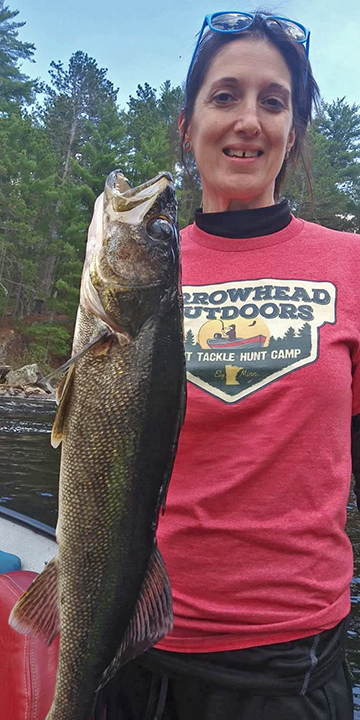 "Walleye - Little has changed with the walleyes this last week. Gold, pink and firetiger colored jigs, tipped with a minnow, continue to be the best way to catch walleyes. Walleyes have begun to scatter as angler reports range from catching trophies right off the dock from 2 to 5 feet, out to 20 feet of water. Shorelines, river mouths and large shallow shoreline flats in 3 to 16 feet of water, are the areas to focus on. Slip bobber and a leech bite just hasn't started. Maybe next weekend. There have been a handful of anglers reporting a good trolling bite during the evening hours with large floating rapalas, trolled over shallow flats.
"Walleye - Little has changed with the walleyes this last week. Gold, pink and firetiger colored jigs, tipped with a minnow, continue to be the best way to catch walleyes. Walleyes have begun to scatter as angler reports range from catching trophies right off the dock from 2 to 5 feet, out to 20 feet of water. Shorelines, river mouths and large shallow shoreline flats in 3 to 16 feet of water, are the areas to focus on. Slip bobber and a leech bite just hasn't started. Maybe next weekend. There have been a handful of anglers reporting a good trolling bite during the evening hours with large floating rapalas, trolled over shallow flats.
Smallmouth Bass - Pre spawn smallies have been on the chow this last week. Many of the walleyes anglers have been reporting the smallies have taken over their walleye spots. Evenings, from 3pm until 8pm, have been the best time to target smallies as this is when the water reaches its peak temperatures. Smallies have been crushing wacky worms, Ned rigs, jerk baits and of course any kind of live bait they see. Large shallow rock flats, bays, out around islands and rivers is where to focus for smallies. Pretty much anything crawfish colored is getting bit.
Northern Pike - Anglers experienced another great week of pike fishing in Ely area lakes. Large suckers, fished under a bobber, continues to be the best way to set your new personal best. Anglers throwing daredevils, spinners and large paddle tails also caught good numbers and size of pike. 5 to 10 feet of water remains, shallow bays, river mouths and right off the dock remains the best place to target big pike.
Panfish - Finally some stable weather has gotten the panfish back up in the shallows and biting. Like with the smallies, afternoons are the best times to target panfish. Anglers have been finding crappies back up in the shallow pencil reeds. Small tube jigs and small hair jigs, with or without a crappie minnow, have been very effective on crappies. Sunfish seem to be hanging out a little deeper in the emerging weedbeds. Sunfish have been happily hitting a small piece of a night crawler, fished right under a bobber.
Stream Trout - Rainbow trout were a popular choice for anglers this last week. Anglers reported catching some nice trout right off the docks or right off shore with nightcrawlers set about 5 to 10 feet deep, under a slip bobber. Small silver and blue spoons were also a good choice for Brookies and Splake, also fished from shore.
Lake Trout - With the winds finally settling down a handful of lake trout reports finally came in. Anglers have been finding lakers while trolling deep diving crankbaits over deep mud flats in 15 to 40 feet of water. Anglers reported lakers with a mixture of bugs and ciscos or smelt in their stomachs. White and blue crankbaits got the job done. Anglers fishing from a canoe mainly used heavy tubes, bucktails and heavy jigging spoons while vertically jigging them as they drifted over deep water." — Arrowhead Outdoors, 218-365-5358
 Lake of the Woods, LOW Tourism May 27, 2025
Lake of the Woods, LOW Tourism May 27, 2025
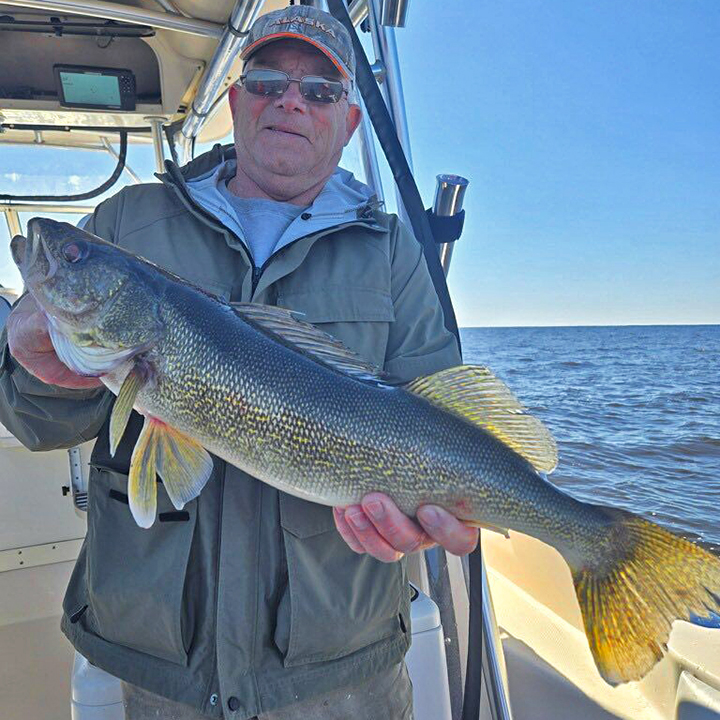 "The jig bite continues to be on fire this week on the south side of Lake of the Woods! Anglers are finding walleyes and saugers in a variety of depths across the south shore. Depending on the forage they’re following, some fish are being found in as shallow as 8 feet of water and others out to 31 feet. The mid-range depths of 23 to 28 feet have been especially productive.
"The jig bite continues to be on fire this week on the south side of Lake of the Woods! Anglers are finding walleyes and saugers in a variety of depths across the south shore. Depending on the forage they’re following, some fish are being found in as shallow as 8 feet of water and others out to 31 feet. The mid-range depths of 23 to 28 feet have been especially productive.
The lake offers a mix of bottom types and structure, and walleyes are showing up on all of it, relating to different forage opportunities. Sand, mud, and rock are all holding fish right now. Anglers are catching fish in shallower water relating to sand, deeper mud flats, and rocky structure in depths ranging from 6 to 29 feet.
The go-to method continues to be anchoring up or spot locking and jigging a minnow. A 3/8 to 1/2 ounce jig tipped with a frozen emerald shiner has been very effective. As always, bright colors are key in the stained waters of LOW—gold, chartreuse, pink, orange, and glow, or a combination of these colors are all producing.
If you’re fishing with a group, it helps to mix up colors and types of minnows to figure out what the fish prefer that day. Frozen emerald shiners are the top bait, but lively fatheads and rainbows are also catching plenty of fish.
Some bonus pike continue to be caught, including by unsuspecting walleye anglers. While many pike have moved into the main lake, there are still some fish lingering in the shallows. If you enjoy chasing big northern pike, now is a great time.
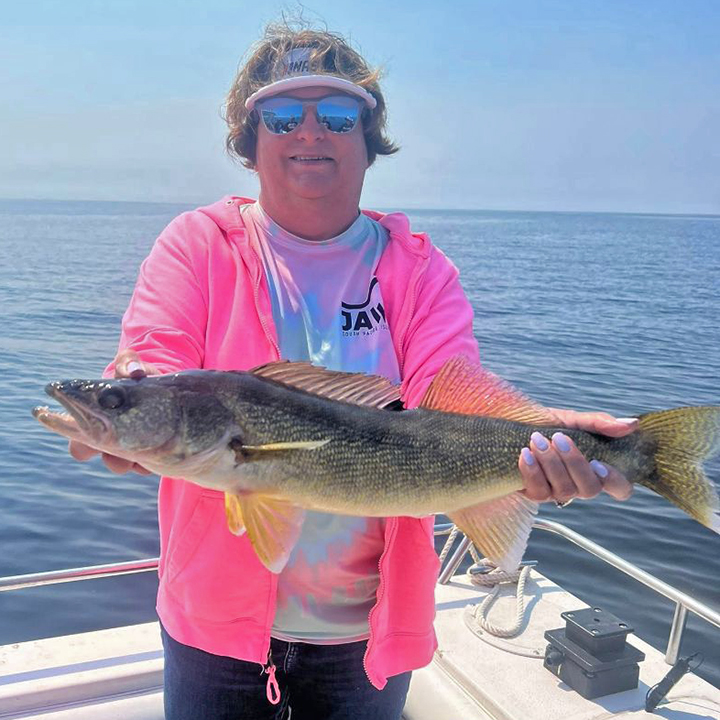 Anglers are reminded that the combined walleye and sauger limit on the Minnesota side of Lake of the Woods is 6 fish, with up to 4 being walleyes. All fish between 19.5 and 28 inches must be released. Anglers are allowed to posess one walleye over 28 inches long.
Anglers are reminded that the combined walleye and sauger limit on the Minnesota side of Lake of the Woods is 6 fish, with up to 4 being walleyes. All fish between 19.5 and 28 inches must be released. Anglers are allowed to posess one walleye over 28 inches long.
The Rainy River continues to give up some nice walleyes. Most anglers are vertically jigging in deeper holes or just off the main channel. Four Mile Bay has produced some solid bites, especially when fishing the edges of the channel and slowing things down.
With water temps climbing and the current still moving, a 3/4 ounce jig tipped with a frozen emerald shiner is working great. Some anglers are switching things up and using spinner rigs tipped with crawlers or trolling shallow diving crankbaits. Both methods allow you to cover water and find active fish. For a fun change of pace, try casting crankbaits, swim jigs, or spinnerbaits along the shoreline, around docks, or into the bays. You’ll catch walleyes, smallmouth bass, pike, and maybe even a surprise or two.
The sturgeon season is currently closed but will reopen on July 1st. From July 1 through September 30, anglers with a sturgeon tag can harvest one sturgeon per calendar year, either 45–50 inches or over 75 inches.
Excellent fishing also continues up at the Northwest Angle. Walleyes are being found in 12 to 18 feet of water, particularly off of shoreline structure, points, and shallow reefs. The jig and minnow bite remains strong, with most anglers anchoring up and working rock or sand transitions.
In addition to jigging, trolling crankbaits along shallow shoreline structure in 6 to 9 feet of water has been productive and will most definitely produce a mixed bag. Focus on "fishy" spots such as points and rock rubble areas. Trolling cranks allows anglers to cover water and find active fish feeding on the move.
As always, anglers are catching a mix of species at the Angle, in addition to walleyes and saugers, jumbo perch, northern pike, and smallmouth bass are in good numbers.
The muskie opener is right around the corner—June 21st for both Minnesota and Ontario’s Zone 5. With good water conditions and lots of bait in the system, it’s shaping up to be another strong season.
With so many fish being caught and great weather ahead, now is a great time to book a trip to Lake of the Woods. Whether you’re fishing with friends, family, or going solo, you’ll find great action and beautiful scenery." — Lake of the Woods Tourism, (800) 382-FISH
 Wired2Fish May 27, 2025 "We Need the Golden Rule in Fishing!"
Wired2Fish May 27, 2025 "We Need the Golden Rule in Fishing!"
 "I’ve had a few genuine run-ins on the water in the past. There were even a few times, back in the day, when I was the aggressor — when fishing meant way too much to me and I took “an eye for an eye” a little too seriously. But it was Moses who said that; Jesus gave us the Golden Rule: “Do unto others as you’d have them do unto you.” I try to live by those words, but it can be mighty hard at times.
"I’ve had a few genuine run-ins on the water in the past. There were even a few times, back in the day, when I was the aggressor — when fishing meant way too much to me and I took “an eye for an eye” a little too seriously. But it was Moses who said that; Jesus gave us the Golden Rule: “Do unto others as you’d have them do unto you.” I try to live by those words, but it can be mighty hard at times.
I was recently fishing alongside a dock at a boat ramp on my home lake, Lake Martin. I had just pulled up and was waiting on my wife to arrive to hop in the boat with me. A speedboat pulled up behind me, so I slid off to the side of the dock opposite the ramp so they could ..." Read Article and Learn More >> "We Need the Golden Rule in Fishing!"
 May 26, 2025 "Things That Go Thump In The Night"
May 26, 2025 "Things That Go Thump In The Night"
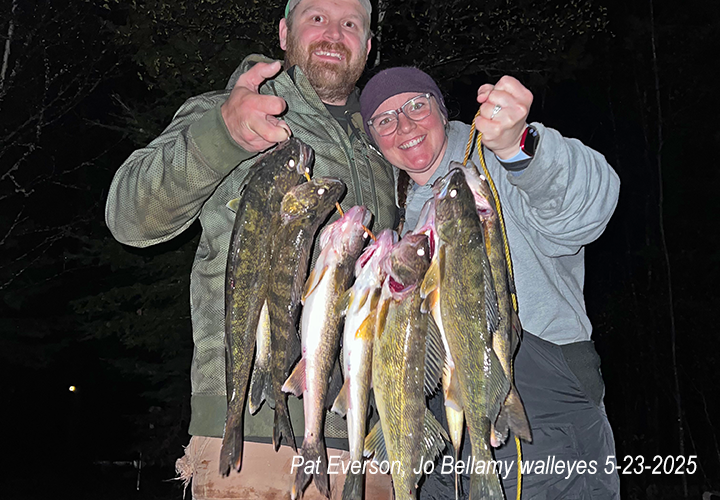 You’re going to find a lot of individuals who have highly specified ideas about how to approach fishing for walleyes at night. “You need” to troll with #6-1/2 jointed silver-gold-yellow-purple Franzanapolvich Monster Maulers at 2.7736 MPH. And unless you’re in 9-7/8 feet of water, with 57-2/3 feet of line behind the boat, you’re not gonna get ‘em.”
You’re going to find a lot of individuals who have highly specified ideas about how to approach fishing for walleyes at night. “You need” to troll with #6-1/2 jointed silver-gold-yellow-purple Franzanapolvich Monster Maulers at 2.7736 MPH. And unless you’re in 9-7/8 feet of water, with 57-2/3 feet of line behind the boat, you’re not gonna get ‘em.”
On the other hand, you’ll run into a few folks who advise, just go out on the lake, find a few fish and use whatever presentation you like, and you’ll get a few. That’s the camp I tend to be in, I believe that catching walleyes at night, is fairly simple, and most folks already have something in their tackle box that will work.
Q) So, Jeff, why don’t we see your photos, and reports about fishing at night? A) Well, for me, there are only 2 reasons not to fish after dark.
- I would have to stay up past 10:00 PM
- I would have to be organized
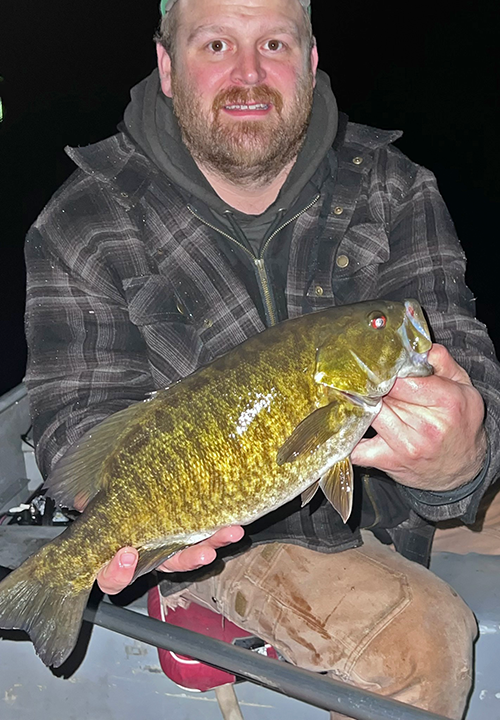 I actually really enjoy night fishing, and if it were not for those 2 main disadvantages, I’d probably do it occasionally.
I actually really enjoy night fishing, and if it were not for those 2 main disadvantages, I’d probably do it occasionally.
There is another point of view, and while not common, is something to be considered. On certain occasions, on specific lakes, walleyes simply will not bite during the daytime.
If you’re thinking oh come on Jeff”, there’s always a way to catch at least some fish during daylight hours. I would have agreed with you until a few years ago, our daughter Joelle and her fiancé’ Patrick invited us to his family cabin up north. They warned us, “we’ll have to fish after dark if we want to catch any walleyes.” Of course, my first thought was that their had to be some way not to waste all of those precious daytime hours. We might as well go out on the lake and figure out a way to catch some kind of sun loving fish.
Long story short, nothing happened until after the sun fell behind the trees. When it did, it was like flipping a light switch, pun intended, and walleye, smallmouth and even some northern pike jumped onto to our lines like magic.
At some of the early meetings of the “Walleye Advisory Committee”, I recall learning from MN DNR fisheries biologists that in some lakes, there are segments of the walleye population that feed exclusively, or at least primarily during the night. I some lakes, the only way an angler can expect encounter those fish is by targeting them after dark.
For Jo and Pat, trolling the shoreline break from 6 to 12 feet of water worked then, and as you can see from the accompanying photos, is still working today. Yesterday, Joelle caught and released this plump 24-inch walleye. “We were trolling at 1.7 MPH, and I was using a black-gold Rapala, no live bait. We were coming off the 6-foot break and the lunker hit hard at about 10 feet deep. The time was around 9:45 PM.”
Trolling with stick baits, like the original Rapala minnow was how I learned to catch fish at night too. Most of my friends who fish at night these days troll with crankbaits too and there are a wide variety of them that work. Salmo Hornets, Rapala Husky Jerks, Berkely Flicker Shads, Cotton Cordell Walleye Divers, and many of the Rebel Lures lineup have been favored baits for me in the past.
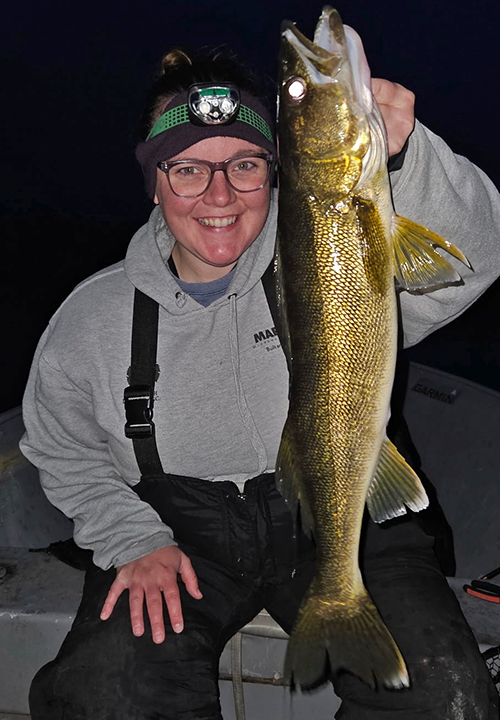 During my formative years as a guide, we had a blast using lighted slip-floats and live bait too. In those days, we motored out to a submerged bar on my favorite metro area lake and anchored the boat. The key spots were small rock piles located in about 10 feet of water. Once we were in position, we set the bobbers for about 8 feet, cast our jig-leech combos over the rock tops and waited for the lights to drift under the water’s surface.
During my formative years as a guide, we had a blast using lighted slip-floats and live bait too. In those days, we motored out to a submerged bar on my favorite metro area lake and anchored the boat. The key spots were small rock piles located in about 10 feet of water. Once we were in position, we set the bobbers for about 8 feet, cast our jig-leech combos over the rock tops and waited for the lights to drift under the water’s surface.
If I was planning a night fishing trip today, I’d pack along a box full of jigs, and plastic tails. Much like fishing for walleyes during the daytime, positioning the boat near “fishy territory” and casting to them is not only highly productive, but for me, more fun. There’s something magical about the feeling that I’ve gone toe-to-toe with a fish and convinced it to strike a piece of plastic. But that’s just me, if you have more fun doing it another way, then do it, it will probably work.
In the past, I’ve seen some critics write that there’s an unfair advantage to fishing after dark. Folks, they believe, have it too easy when they fish at night, and they catch too many fish. I’m sorry, but I can’t buy into that thinking.
For one thing, it isn’t always as easy as it sounds. There are plenty of nights when the catch rate is no better than any average daytime fishing trip. Then there’s the mortality factor, catching fish at night is usually accomplished by fishing in shallower water than we fish during the daytime. I would rather see an angler release 10 fish caught in 8 feet of water than 2 fish caught in 30 feet of water. Likewise, I’d rather remove an artificial lure from a fish’s mouth, than drag a deep-hooked live bait rig out of its throat. Again, that’s just my personal judgement, but I do believe that I’m on the right track.
Still, finding and catching walleyes after dark isn’t that complicated, just use the same locational methods for finding fish that you would do during a daytime fishing trip. Lure selection isn’t overly precise either, just play to your own strengths. If you love jigging, then try some of the artificial tails and jigging lures that you’d use in the daytime. Same advice for bobber fishing, or trolling, you likely already own baits and gear that will work, so start simple, and specialize later, if you decide to get serious about night fishing.
Like I said, staying organized is important. So, if you do plan to take a crack at fishing after dark, make sure all unnecessary gear is stowed away, and that every tool you’ll need is in a predictable location, and within easy reach. Make sure all your navigation lights are working, and that you have headlamps, or some other convenient lighting for unhooking fish and the like. A navigation chart, either on your fishing graph, or an app on your phone is essential too.
If you’re thinking that you want to be more like Jo and Pat, and you’re willing to give up a few hours of sleep, then you should give it a try. If you wind ep getting addicted to night fishing, well, I can’t help you with that. ![]() — Jeff Sundin, The Early Bird Fishing Guide Office Cell Call or Text 218-245-9858 or Email on Facebook on X
— Jeff Sundin, The Early Bird Fishing Guide Office Cell Call or Text 218-245-9858 or Email on Facebook on X
 Cutfoot Sioux, Lake Winnie Memorial Day Fishing Report May 25, 2025
Cutfoot Sioux, Lake Winnie Memorial Day Fishing Report May 25, 2025
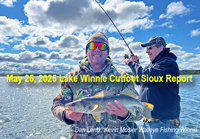 "Cold water temperatures, partially responsible for the clear water conditions ranged from 54 to 56 degrees on Friday. Mid-day temperatures remained cool again on Saturday, holding stubbornly in the 55-to-57-degree territory. As of this morning, Sunday May 25, 2025, cold overnight air temperatures have likely forced surface water lower again, we’ll begin hearing reports from guests about that later today.
"Cold water temperatures, partially responsible for the clear water conditions ranged from 54 to 56 degrees on Friday. Mid-day temperatures remained cool again on Saturday, holding stubbornly in the 55-to-57-degree territory. As of this morning, Sunday May 25, 2025, cold overnight air temperatures have likely forced surface water lower again, we’ll begin hearing reports from guests about that later today.
Interestingly, the key depth ranges for locating walleyes remain relatively shallow when compared to past seasons. Most anglers are finding the best schools of fish in 10 to 16 feet of water, over soft bottom flats. The best areas feature a slower tapering breakline, rather than steep drop-offs, and the presence of newly emerging vegetation helps concentrate fish.
Deeper water breaklines, like the river channel, and areas where points or flats extend out to the lake’s main basin contain a handful of fish too. But are not prime areas at the moment. The water depths for fish found in these areas have ranged from 22 to 26 feet of water. Anglers have commented that when fishing these depths, more northern pike have been caught, than walleyes.
The best presentation overall was ..." Read >> Bowen Lodge Lake Winnie Walleye Fishing Report May 25, 2025 May 25, 2025 "Gone Outdoors Podcast Sundin Thoughts On Walleye Limits"
May 25, 2025 "Gone Outdoors Podcast Sundin Thoughts On Walleye Limits"
 "Kyle Agre and Scott Brewer, Co-Hosts of "Gone Outdoors" at KFGO 790 AM in Sioux Falls, SD caught up with Jeff Sundin this weekend. First up on this segment, they chat with the Minnesota Fishing Hall of Fame, "Early Bird Fishing Guide" about fishing conditions in north central Minnesota. Live on the water, Sundin provides a brief fishing update, and outlook for the days ahead.
"Kyle Agre and Scott Brewer, Co-Hosts of "Gone Outdoors" at KFGO 790 AM in Sioux Falls, SD caught up with Jeff Sundin this weekend. First up on this segment, they chat with the Minnesota Fishing Hall of Fame, "Early Bird Fishing Guide" about fishing conditions in north central Minnesota. Live on the water, Sundin provides a brief fishing update, and outlook for the days ahead.
Next, Agre and Brewer quiz Sundin about his thoughts on Minnesota's DNR effort to reduce the statewide walleye limit from 6 fish, down to 4. The longtime fishing guide explains how the proposed regulation would affect certain segments of Minnesota's anglers differently from others. Local anglers, fishing pros and guides who favor the new regulation benefit becasue of their easy access to fishing opportunity.
On the other hand, the proposed regulation discriminates against touirists who visit from long distances. For visiting anglers, the regulation is unfair because they ..." Listen and Learn More >> Brewer, Agre Gone Outdoors Podcast May 25, 2025
 May 23, 2025 "A Crappie Memorial Weekend Ahead!"
May 23, 2025 "A Crappie Memorial Weekend Ahead!"
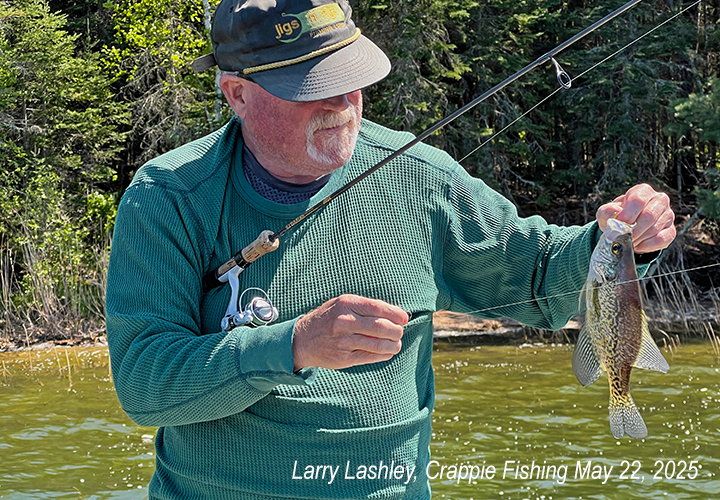 Fishing with Larry Lashley, Tim Fischbach and friends, has been part of my spring routine for about 35 years now, maybe more. During that time, we’ve fished in most every weather condition you can imagine. So, we’ve learned that when it comes to what we’ll catch, and where we’ll catch them, timing is everything. Usually, the duration of their trips is 2-1/2 days, and we spend most of our time fishing for walleyes. In recent years, we’ve developed a tradition of finishing the last half day in pursuit of crappies. After a week or more of fishing on larger lakes, in heavy, turbulent conditions, I was all in for a day on smaller, calmer water.
Fishing with Larry Lashley, Tim Fischbach and friends, has been part of my spring routine for about 35 years now, maybe more. During that time, we’ve fished in most every weather condition you can imagine. So, we’ve learned that when it comes to what we’ll catch, and where we’ll catch them, timing is everything. Usually, the duration of their trips is 2-1/2 days, and we spend most of our time fishing for walleyes. In recent years, we’ve developed a tradition of finishing the last half day in pursuit of crappies. After a week or more of fishing on larger lakes, in heavy, turbulent conditions, I was all in for a day on smaller, calmer water.
Late Wednesday evening, the rain stopped, and the east winds went calm. Overnight, the skies cleared, and the breeze shifted to the north. Thursday morning featured crisp temperatures, bright sunshine, blue skies, and a cool north wind. The stage was set for a tough day of fishing, unless … we could “get lucky” and find crappies moving back toward the shoreline. Back toward the shoreline from where?
With crappie location in mind, recall this snippet from the report May 15, 2025. “We caught 8 or 9 fish in total, and all were singles which we found scattered around the lake in random locations. One of them was taken on a rocky hump in 15 feet of water, all the rest were taken from patches of cabbage weeds. One of the fish was a dark black male, a signal that spawning will occur soon. Apparently, crappies there are preparing to spawn but have not yet fully committed to the process.”
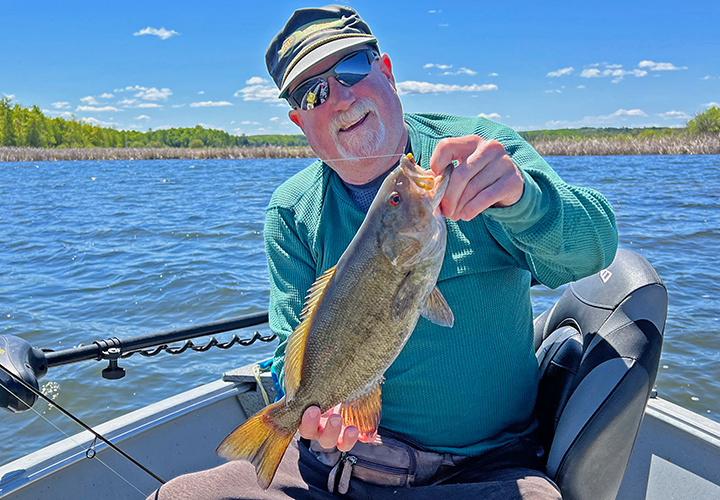 Okay, so we knew that crappies had been moving toward shallow spawning structure before the unsettled weather arrived last weekend. What we didn’t know was if the cold front and turbulence was enough to stop them from spawning altogether. So, the “get lucky” part of the equation would occur if the fish had not yet attempted to set up in spawning habitat, or not. If not, then maybe the sunshine would warm the shallow water, and they’d begin moving back into the shoreline.
Okay, so we knew that crappies had been moving toward shallow spawning structure before the unsettled weather arrived last weekend. What we didn’t know was if the cold front and turbulence was enough to stop them from spawning altogether. So, the “get lucky” part of the equation would occur if the fish had not yet attempted to set up in spawning habitat, or not. If not, then maybe the sunshine would warm the shallow water, and they’d begin moving back into the shoreline.
When we arrived at the lake, the surface water temperature was 54 degrees, not encouraging but it was what it was. I drove to the first spot, a cabbage patch located in about 8 feet of water, that lays adjacent to a patch of bulrushes where we’ve found spawning crappies in the past. Fishing with small jigs, plastics, minnows and small snight crawlers, we drifted the edges of the vegetation but found no crappies or sunfish either.
Next, I moved shallow, set up within casting distance of the bulrushes, and we set bobbers about 2 feet above our lures. There were no crappies here either, but there were a few rock bass, a small largemouth bass, and one nice size smallmouth bass that Larry caught.
Next, I moved to another cabbage patch that had been good for us in the past. Here, we rigged up the spinners, tipped our hooks with small minnows and began trolling the cabbage patch. We caught one northern pike after another, and could have caught dozens of them, but they were too small to get our attention. So, we left that spot, tried trolling another weedline and discovered even smaller northern pike. From then on, wherever we tried trolling spinners, pike were the only fish striking them. So, we abandoned that presentation and returned to bobber fishing.
I guess we tried 2 or 3 more patches of bulrushes, caught some more rock bass, and another small largemouth bass. By now it’s about 2:15, Larry is thinking about heading home by 3:00 PM and it’s looking like he’ll do it without any crappies in his larder. “Okay, I guess we’re a little too early this time, maybe they’ll be more active when you come back in June”, I said. “But before we head out, let’s try one more spot on the way out of here”, I added.
Okay, so that one more spot was a good one. Shallow bulrushes along a shoreline of mixed rock, gravel and marl. The sunshine, combined with a light inbound breeze had warmed the water up to about 57 degrees and there were crappies exploring the shallows. Suspended about 2 feet below our clip-on bobbers, the small, 1/16-ounce Live Bait Jigs tipped with crappie minnows did the trick.
“I knew you’d figure out a way to keep me out here past 3:00”, Larry said. I didn’t plan it that way, but I guess sometimes I’m just too stubborn to quit and I’m glad for that, sometimes. We didn’t have to delay Larry’s departure too much though, there were just enough crappies in there to get 10 fish for him to take home. The task was completed by about 3:15 and that gave me an opening to make an honorable exit from the lake.
Without knowing what’s happening on every lake, I can only generalize. We have a warming trend moving in, more sunshine on the way, and lilacs are in bloom everywhere I look. All indicators are pointing in the direction of this Memorial Day holiday weekend being almost perfect timing for crappie fishing. So, if you’re headed for the lake, try checking out a few of your favorite crappie fishing spots.
For me, walleyes are back on the agenda today, and I'll let you know how that project plays out later. Have a fabulous Memorial Day, and be safe on the lakes and roads. ![]() — Jeff Sundin, The Early Bird Fishing Guide Office Cell Call or Text 218-245-9858 or Email on Facebook on X
— Jeff Sundin, The Early Bird Fishing Guide Office Cell Call or Text 218-245-9858 or Email on Facebook on X
 Ely Area, Arrowhead Outdoors Fishing Report May 21, 2025
Ely Area, Arrowhead Outdoors Fishing Report May 21, 2025
 "Walleye - The much feared cold snap did little to slow down the walleye bite. Anglers that braved the cold found walleyes still snapping in the 15 foot of water range. Here a simple 1/4 ounce jig, tipped with a pike sucker, got the hardest hits. There were a few reports of leeches, soft plastics and crankbaits starting to work in the shallows, right off the dock in 2 to 8 feet of water. Anglers should still be focused on current areas, large shallow flats and right off their docks for walleyes. Pink, white and gold continue to be the hot colors to have.
"Walleye - The much feared cold snap did little to slow down the walleye bite. Anglers that braved the cold found walleyes still snapping in the 15 foot of water range. Here a simple 1/4 ounce jig, tipped with a pike sucker, got the hardest hits. There were a few reports of leeches, soft plastics and crankbaits starting to work in the shallows, right off the dock in 2 to 8 feet of water. Anglers should still be focused on current areas, large shallow flats and right off their docks for walleyes. Pink, white and gold continue to be the hot colors to have.
Northern Pike - Cold, cloudy weather had the pike fishing hot, hot, hot! Many pike anglers reported excellent pike fishing this last week. Bobber fishing with medium to large suckers or large creek chubs were very hot. Shallow bays, current areas and again, right off the dock were the best places to tie into a giant pike.
Stream Trout - Rainbow trout and Brook trout didn't have any issue with the cold snap either. Anglers fishing from shore reported catching some nice trout while fishing with a night crawler under a bobber about 5 to 10 feet down. Brook trout anglers did well casting small silver and blue spoons, white twister and floating a crawler off the bottom.
Lake trout - Lake trout reports remain elusive. High winds are likely the main reason. Not very much fun trolling/jigging in a boat or canoe in whitecaps. The few reports we have gotten have been trolling spoons or deep diving crankbaits down 20 to 30 feet of water, over deep mud flats.
Smallmouth Bass - Now the smallmouth bass were affected by the cold snap. Smallmouth reports quickly dried up when the temperature dropped. As temps start to rise again, anglers should expect smallies to start returning to the shallow flats, in 10 feet of water and less, that are covered with large rocks. Suspending jerk baits and NED rigs will be the baits to throw at the smallies.
Panfish - Panfish too were not enjoying the cold snap. Crappies and sunnies dropped out of the pencil reeds and are now being found in deeper water at the mouth of these same bays they were just in. Crappies minnows floated under a bobber managed to catch a few crappies and sunfish for anglers." — Arrowhead Outdoors, 218-365-5358
 Wired2Fish May 21, 2025 "Big Bass Are Booming at Virginia’s Stocked Smith Mountain Lake"
Wired2Fish May 21, 2025 "Big Bass Are Booming at Virginia’s Stocked Smith Mountain Lake"
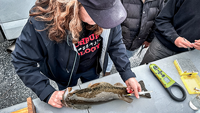 "Chad Green and Johnny Martin had high hopes as they headed out on a recent chilly Saturday morning for a mid-March bass tournament on Smith Mountain Lake, their home waters just southeast of Roanoke, Virginia.
"Chad Green and Johnny Martin had high hopes as they headed out on a recent chilly Saturday morning for a mid-March bass tournament on Smith Mountain Lake, their home waters just southeast of Roanoke, Virginia.
The pair had been regularly weighing five-fish limits topping 25 pounds at tournaments earlier in the year, and just a couple of days before this tournament event (sponsored by the Angler’s Choice boat dealership), Green boated a 9-pound 10-ounce largemouth while pre-tournament scouting.
They felt good about their chances of taking the tourney’s $10,000 top prize, but were concerned about the arrival of ..." Read Article and Learn More >> Big Bass Are Booming at Virginia’s Stocked Smith Mountain Lake
 May 21, 2025 "Minnesota Musky Management Plans Announced"
May 21, 2025 "Minnesota Musky Management Plans Announced"
 Aaron Meyer, Co-Chair of the Minnesota Muskie and Pike Alliance wrote: "Great news muskie anglers! The new Long-Range Muskie Management Plan is complete! This is the document that will guide Minnesota muskie management for the next 15 years.
Aaron Meyer, Co-Chair of the Minnesota Muskie and Pike Alliance wrote: "Great news muskie anglers! The new Long-Range Muskie Management Plan is complete! This is the document that will guide Minnesota muskie management for the next 15 years.
The actual writing of the document took some time, but the hardest part was getting DNR Management to acknowledge and accept the shortcomings of the current muskie management system. The great news is that this new plan is very well thought out and does a great job of addressing all of the concerns we've been expressing over the last 15 plus years!
Those of us that have had the opportunity to review the draft are pleased with its contents. Every single piece of this plan is the result of years of hard work and of never giving up on fighting for better muskie fisheries.
Whereas the last Long-Range Plan focused largely on expanding muskies to new waters, this plan focuses mostly on improving muskie populations and quality angling opportunities on existing muskie waters. The biggest highlights are:
- Prioritizing improving muskie fishing on "The Big 3" -Mille Lacs, Vermilion, and Minnetonka.
- Improving muskie production, with a significant shift towards stocking yearlings rather than fingerlings in some waters.
- Hiring a muskie specialist to help bring the new plan to fruition.
Steps have already been taken towards achieving some of these goals. Vermilion received a bump in its stocking quota several years ago, and fingerlings seems to do well there, so that program won't be reassessed until after the next population estimate in 2027-2028. Minnetonka has already been shifted towards yearling stocking. As soon as yearling production can be ramped up, Mille Lacs will be switched to yearling stocking, which will lead to significantly higher recruitment of stocked muskies.
Rearing yearlings on a consistent basis will be challenging, but there are already plans for improving production at current facilities as well as plans for an entirely new hatchery with space dedicated to yearling muskie production.
The DNR used to have a dedicated muskie specialist, or "topical expert" as it's written in the new plan, but has not filled that position in many years. In my opinion, filling that role with someone who can oversee all aspects of muskie management and help facilitate whatever steps need to be taken, is going to be the most important step in achieving all of the goals of this new plan. In fact, my personal input right now will focus on strongly encouraging that aspect of the new plan.
The DNR is accepting public input and comments on the new plan through June 12, 2025.
The DNR staff that serve on the muskie technical committee worked hard and did a great job putting together a very important plan. I would encourage you all to send your personal input along with a thank-you for their efforts. Email: mnmuskieplan2025@state.mn.us
It's going to be a challenge to accomplish all of these goals, but this plan is a massive step towards better muskie fishing in Minnesota! Please pass this message along to all of your muskie-friendly contacts."
For more information about the Minnesota Musky Management Plan, visit >> Minnesota DNR Muskellunge Home Page
 May 20, 2025 "Catching the Catch-Able"
May 20, 2025 "Catching the Catch-Able"
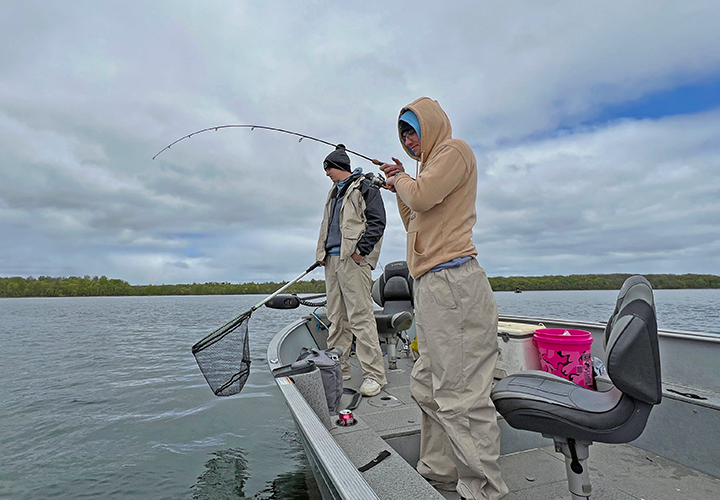 I can’t tell you that the recent cold front has made fishing conditions comfortable, that would be a stretch. What I can say is that despite these cold and blustery conditions, fish are still catch-able. Even fishing in the snow flurries that occurred on Sunday, my crew, the Krug family, amassed a larder of 16 keepers on Lake Winnie.
I can’t tell you that the recent cold front has made fishing conditions comfortable, that would be a stretch. What I can say is that despite these cold and blustery conditions, fish are still catch-able. Even fishing in the snow flurries that occurred on Sunday, my crew, the Krug family, amassed a larder of 16 keepers on Lake Winnie.
On a solo trip with Ken Seufert yesterday, we fished at a smaller lake and managed a reasonable catch of keeper walleyes, along with releasing a handful of bonus smallmouth bass and some northern pike.
On both trips, it took me searching a few spots before locating fish. But once they were spotted, typical jig and minnow presentations triggered them to strike. We fished in water depths of about 10 to 14 feet, depending on the spots and in every case, walleyes were scattered horizontally along the breaklines.
In the strong wind, ¼ ounce jigs worked better for us than did the 1/8-ounce sizes that I’d typically prefer. On Winnie, we felt that smaller minnows, both fatheads and rainbows worked better than shiners did. Yesterday, it didn’t matter much which minnows we used, all of them were equally effective.
So, why is it that later in the summer, a 30 to 40 degree drop in temperature kills the fishing action, but during spring, it doesn’t?
I think there are several factors to consider but there are 2 that dominate. First is that walleyes are still mostly occupying shoreline related structures. They haven’t migrated into summer locations, so we are simply encountering greater numbers of fish. So, even if we need to work harder to illicit a strike, we have more opportunities to present our lures to fish. Sooner or later, some of them strike, even while others don’t.
Second, I think, is because surface water temperatures have never warmed up into the “summer range”.
 The warmest surface water reading I’ve seen this spring was about 66 degrees. On the lake bottom, temperatures probably never exceeded 60 degrees in shallow water and remained even cooler in deeper water. So, even with a 40 degree drop in outside air temperature, surface readings have only fallen back to about 56 degrees or so. The difference between pre-cold-front and post-cold-front temperatures is not great enough to shock the fish in the same way that it would during mid-summer.
The warmest surface water reading I’ve seen this spring was about 66 degrees. On the lake bottom, temperatures probably never exceeded 60 degrees in shallow water and remained even cooler in deeper water. So, even with a 40 degree drop in outside air temperature, surface readings have only fallen back to about 56 degrees or so. The difference between pre-cold-front and post-cold-front temperatures is not great enough to shock the fish in the same way that it would during mid-summer.
Then we should remember too that for the fish, food supplies during early spring are much lower that they will be later in summer. So, if there’s less food available, they’re more likely to strike our lures. That is, if we present them correctly.
We’ve all had it happen; we’re fishing with a friend or maybe a small group of them. Someone is catching fish, but someone else isn’t. “Jig it like this, wiggle it like that, cast it over there” and other advisories aimed at helping, just don’t seem to work. No matter how helpful friends are, there is something holding back their friend.
Paul Guanzini, a longtime friend and occasional fishing customer wrote to me about a situation like that. Guanzini, “Morning Jeff, I wanted to share my experience on Winne this past week. My buddies and I started fishing Winnie on Monday evening with a few fish caught in 12 feet of water just outside of the dam bay area.
The two guys in my boat caught them, however I never touched a fish. The next day they caught 7 keeper fish and 2 slot fish, and while I did catch a few pike, I still never touched a Walleye. Wednesday brought the same story, they caught, and I watched and drove the boat.
What was the problem? Same speed, same depth, same size and color live bait jig and same Shiners. My buddies had been telling me that my 7-foot long, 6-pound test fluorocarbon leader tied to 10-pound test Fireline was the problem. I stuck to the fact that I had been using this setup for years and always caught fish.
After thinking about it all night I tried adding several feet of 6-pound test fluorocarbon on to the Fireline and what do you know? On Thursday I caught Walleyes too. They both were using straight 6-pound mono on their reels. Our theory is that Winnie is now so clear that the fish were spooked by my Fireline. I assume this is a result of Zebra mussel infestation and other lakes will require the same change to my fishing strategy, clear line and further back from the boat.” Take care, Paul’.
Paul, I don’t have a lot to add, among my fellow guides, it is a commonly held belief that “boat shyness” has become a factor in catching walleyes. We do know that walleyes depend on their keen eyesight when feeding. So, it seems fair to assume that the visibility of your fishing line is a factor.
I’ll throw in one additional observation from my personal experiences. Fireline, along with all of the other brands of no-stretch fishing lines fish differently than straight monofilament does. If one angler is a fishing braid, while another is using mono, what appears to us to be identical jigging action, does not translate to identical action under the water. When you think about it, the stretch of monofilament subdues or reduces the action that reaches the fishing lure. So, there are times when my customers have needed to adjust the action they impart before they begin triggering fish to strike.
Either way, I’m glad you sorted out a solution and caught some walleyes before your trip ended. I’m grateful too that you shared the story with your fellow anglers, I’m sure it will help!
Okay, so today appears to be another test of physical endurance. More wind, more cold temperatures and more … fish, hopefully. I’ll let you know how it goes tomorrow. If you’re heading toward the lake, keep the dry side up, it’s gonna be a rough one. ![]() — Jeff Sundin, The Early Bird Fishing Guide Office Cell Call or Text 218-245-9858 or Email on Facebook on X
— Jeff Sundin, The Early Bird Fishing Guide Office Cell Call or Text 218-245-9858 or Email on Facebook on X
 Lake of the Woods, LOW Tourism May 20, 2025
Lake of the Woods, LOW Tourism May 20, 2025
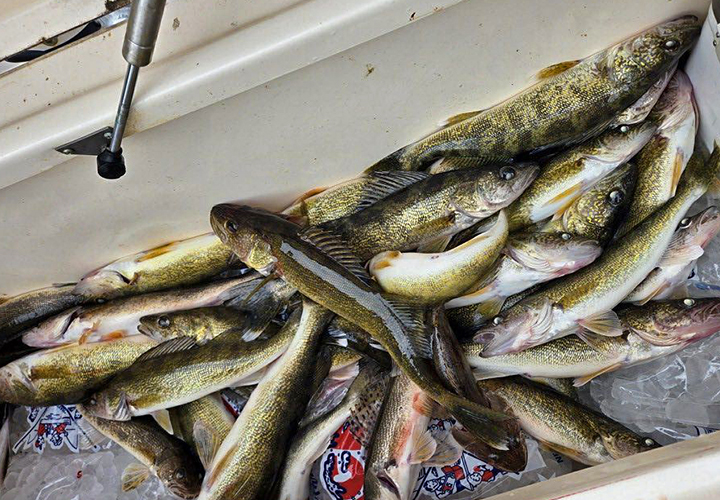 "Despite fluctuating weather systems rolling through, it's been a good week of walleye fishing along the south shore of Lake of the Woods. Walleyes were found in varrying areas and depths ranging from 8 to 31 feet of water. There's been a nice mix of both walleyes and saugers, many providing families with the traditional fish dinners at the end of their fishing trips. Anglers fishing the Rainy River found similar results as well.
"Despite fluctuating weather systems rolling through, it's been a good week of walleye fishing along the south shore of Lake of the Woods. Walleyes were found in varrying areas and depths ranging from 8 to 31 feet of water. There's been a nice mix of both walleyes and saugers, many providing families with the traditional fish dinners at the end of their fishing trips. Anglers fishing the Rainy River found similar results as well.
The "go-to" presentation has been a jig and a minnow, fished vertically over the side. Fishing the lures slowy works best, fascilitated by anchoring, of "spot-locking" the boat. Bright colors were the best; gold, orange, chartreuse, pink and glow white, or a combination of these colors often with some gold has been working well. Minnows have been working the best on a jig. Frozen emerald shiners are a preferred bait by many, but fatheads and rainbows catch a lot of walleyes as well.
Anglers are catching some nice pike, with many of them being caught by walleye anglers jigging. There are plenty of pike to be had for those who like to target them. Some fish are still in the shallows. Larger fish have slid into the lake.
The walleye and sauger limit on LOW is a combined limit of walleyes and saugers of 6, with up to 4 being walleyes. The protected slot is 19.5 to 28.0 inches, those fish must be released. Anglers are allowed to harvest, and posess one walleye over 28 inches.
On the Rainy River, there were some very good walleye reports again this week. Some "post-spawn" fish remain in the river from their spawning run, and other resident fish remain in the river throughout the year. Good walleye reports from Four Mile Bay. Get off of the edge of the channel and jig with a minnow.
Most anglers are fishing with a jig and minnow vertically jigging. With the current, a 3/4 ounce jig vertically jigged is working out well.
Sturgeon fishing is closed and will re-open again July 1st. From July 1 through September 30, anglers can harvest one sturgeon 45 to 50 inches or over 75 inches if they have a sturgeon tag. One sturgeon per angler per calendar year. Summer is a great time to fish the river.
Up at the Northwest Angle, good reports for walleyes this week despite various pressure systems moving through. Walleyes are hanging out on shoreline structure such as points, weed edges and neckdown areas. A jig and a minnow is the goto presentation. Multispecies action for many anglers with jumbo perch, pike, and smallmouth bass in the mix. The muskie opener in MN and Ontario Zone 5 is June 21st for both areas." — Lake of the Woods Tourism, (800) 382-FISH
 Cutfoot Sioux, Lake Winnibigoshish 2025 Fishing Season Outlook May 19, 2025
Cutfoot Sioux, Lake Winnibigoshish 2025 Fishing Season Outlook May 19, 2025
 "As inconsistent as the weather has been, walleye fishing has been the complete opposite. Our guests and visiting anglers have consistently located and caught good numbers of walleye. There are schools of fish on all 4 sides of the lake, and while there is no “hot bite” going on anywhere, there is a steady bite going on everywhere.
"As inconsistent as the weather has been, walleye fishing has been the complete opposite. Our guests and visiting anglers have consistently located and caught good numbers of walleye. There are schools of fish on all 4 sides of the lake, and while there is no “hot bite” going on anywhere, there is a steady bite going on everywhere.
For most folks, fishing shoreline breaks and flats in water depths of 9 to 12 feet have been a good starting point. Occasionally, walleyes are found deeper, in water depths of 18 to 24 feet, also along the shoreline drop-offs. Shallow water, 6 to 8 feet has produced some fish too, especially in areas of the lake where shiner minnows and other small gamefish roam the sand flats during spring. For now, there are still shiner traps in the lake, and these provide clues about where some of the better shallow water spots are located.
For walleyes, jig and minnow presentations are the most consistent. Standard operating procedure is to" Read >> Bowen Lodge Lake Winnie Fishing Report May 19, 2025 May 16, 2025 "Linking the Link-Able"
May 16, 2025 "Linking the Link-Able"
 Most frequent visitors to these reports’ pages take one look at the accompanying photo and already know what it means to anglers. In case you don’t, just check in here with Kelly Damon she knows the answer firsthand. Click here and >> Ask Kelly what blooming lilacs mean to anglers?
Most frequent visitors to these reports’ pages take one look at the accompanying photo and already know what it means to anglers. In case you don’t, just check in here with Kelly Damon she knows the answer firsthand. Click here and >> Ask Kelly what blooming lilacs mean to anglers?
Okay, sorry for the tease, but it’s 4:30 in the morning, what else can I do for fun?
The blooming lilacs were growing near the fish cleaning station at the US Army Corps of Engineers, Pokegama Dam campground near Grand Rapids on May 15, 2025. Seeing them growing there piqued my interest, so on my drive home, I watched the neighborhood streets for signs of a wider spread bloom going on. I did see a few other lilac buszhes in bloom, but didn’t see signs of a widespread bloom going on.
The photo of Kelly’s fish was taken on May 15 too, on a small lake south of Grand Rapids. And seeing that fish, on that lake, piqued my interest too, and started me thinking. Maybe the crappies were moving toward shallow water spawning structure? However, much like the limited sightings of flowing lilacs, both crappie sightings and catches were equally sporadic.
We caught 8 or 9 fish in total, and all were singles which we found scattered around the lake in random locations. One of them was taken on a rocky hump in 15 feet of water, all the rest were taken in patches of cabbage weeds. One of the fish was a dark black male, a signal that spawning will occur soon. Apparently, crappies there are preparing to spawn but have not yet fully committed to the process.
All of the fish we caught on Thursday, no matter the species were taken on 1/8 ounce Lindy Live Bait jigs. Most were tipped with minnows, but a few fish were caught with the jigs sporting a half night crawler. With the strong winds, alternative presentations were out of the question.
I think it’s good news that we didn’t find any fish in the shallow spawning areas. With a fairly extreme cold front moving in, an interrupted spawning cycle probably would have shunted the entire year class of crappies, at least on that lake. Why? Because once crappies move onto spawning beds, they only stay there if weather conditions remain favorable. If weather conditions force them out during the spawning session, they most likely will not return.
This behavior is the “quirk” that explains why some lakes have only infrequent year classes of crappies. Only when Mother Nature provides ideal spawning conditions, do they complete a full spawning cycle, and produce a strong year class. Only time will tell, but by the time this cold front pass, and conditions stabilize, crappies may still pull off a successful spawning cycle.
Despite the sporadic nature of our crappie action, it was still the highlight of our day. Strong winds, and occasional storms hampered my creativity. At one point the wind became so strong that the whitecaps broke the straps of my drift sock. That was a first for me, and the turbulence meant that finding workable fishing spots, even on the small lake was hard. Walleyes, likely because of the storms, had a case of lockjaw and I could not fish slow enough to finesse them into biting. What kept us busy instead were a few quality perch, a couple of sunfish, and a hundred small northern pike.
Okay, so that’s the report from Thursday and today doesn’t promise to provide much relief. High temperatures today are predicted to range from 48 to 54 degrees, roughly 30 degrees colder than yesterday. Showers likely, cloudy, south winds gusting to 25 mph and chance of precipitation is 70%. I’m not sure how many of us will see each other on the lake, but if you do see us out there, be sure to wave! If not, we’ll compare notes later. ![]() — Jeff Sundin, The Early Bird Fishing Guide Office Cell Call or Text 218-245-9858 or Email on Facebook on X
— Jeff Sundin, The Early Bird Fishing Guide Office Cell Call or Text 218-245-9858 or Email on Facebook on X
 Wired2Fish May 16, 2025 "Do Bass Have A Memory, and Can They Learn?"
Wired2Fish May 16, 2025 "Do Bass Have A Memory, and Can They Learn?"
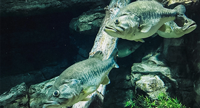 "How many times have you seen a lure burst onto the scene and become wildly popular for a while — everybody’s throwing it; everybody’s catching bass on it — then, mysteriously, the bite slows down and that bait becomes yesterday’s news?
"How many times have you seen a lure burst onto the scene and become wildly popular for a while — everybody’s throwing it; everybody’s catching bass on it — then, mysteriously, the bite slows down and that bait becomes yesterday’s news?
Well, it’s no coincidence. Fisheries biologists and professional anglers alike are convinced that bass have the ability to learn. When they’ve had a negative experience with a bait they’ve seen too often, they are going to remember. Exactly how long they remember is up for debate.
Let’s not give them too much credit; they aren’t swimming geniuses, but they can ..." Read Article and Learn More >> Do Bass Have A Memory, and Can They Learn?
 Lake of the Woods, LOW Tourism May 15, 2025
Lake of the Woods, LOW Tourism May 15, 2025
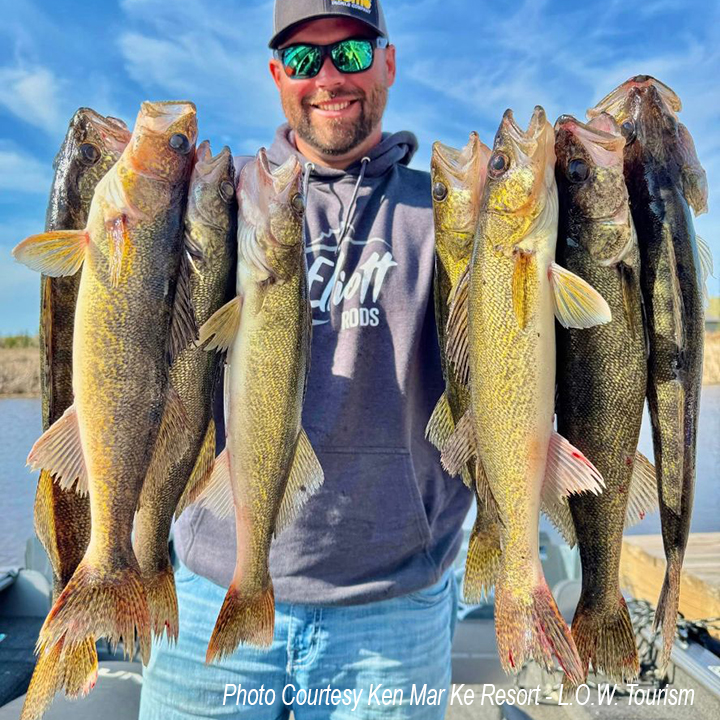 "It was an excellent Fishing Opener on the Minnesota side, south shore of Lake of the Woods. Some hot walleye action with most anglers finding walleyes and saugers. Walleyes were found in many locations across the south shore in anywhere from 15 to 31 feet of water. Kind of a big spread, but not every fish is targeting the same forage. Good success from east to west.
"It was an excellent Fishing Opener on the Minnesota side, south shore of Lake of the Woods. Some hot walleye action with most anglers finding walleyes and saugers. Walleyes were found in many locations across the south shore in anywhere from 15 to 31 feet of water. Kind of a big spread, but not every fish is targeting the same forage. Good success from east to west.
The go to method was a jig and a minnow over the side of the boat while anchored up or spot locked. With the stained waters, brighter colors are normally best. Gold, orange, chartreuse, pink and glow white, or a combination of these colors, normally works out well. If you are fishing with others, it is helpful to start with different colors and even different minnows. Some anglers stick with frozen emerald shiners, others might put on a lively fathead or rainbow. Work together to get the walleyes dialed in.
The walleye and sauger combined limit on LOW is 6 fish total, of which no more than 4 may be walleyes. Walleye btween 19.5 and 28.0 inches are protected, and must be immediately released. Anglers are allowed one walleye over 28 inches in posession.
Naturally, some big pike caught this weekend. Some by anglers targeting pike, others by unsuspecting walleye anglers.
There were great walleye reports on the Rainy River. Plenty of nice fish are still in the river, both big fish, slots and eaters. Just like the lake, most anglers went with a jig and minnow vertically jigging. Good reports from Four Mile Bay in addition to various stretches up river.
Sturgeon fishing continues through May 15th and the spring season has been excellent. The sturgeon season will re-open again July 1st. From July 1 through September 30, anglers can harvest one sturgeon 45-50 inches or over 75 inches if they have a sturgeon tag. One sturgeon per angler per calendar year. Summer on the river is a beautiful time to soak nightcrawlers!
Up at the Northwest Angle, anglers reported a great fishing opener as well. As expected, walleyes were found on shoreline structure such as points, weed edges and neckdown areas. With the many islands in this part of the lake, there is a ton of structure and so many spots to fish. This time of the year, it is hard to beat a jig and a minnow which was the go to for most anglers
Multispecies action is common up at the Angle with jumbo perch, pike, and smallmouth bass in the mix for walleye anglers. For those who enjoy smallmouth bass fishing, May and June can be lights out amongst the islands. As walleyes get most of the attention, smallmouth get missed but are in big numbers. The muskie opener in MN and Ontario Zone 5 is June 21st for both areas." — Lake of the Woods Tourism, (800) 382-FISH
 Ely Area, Arrowhead Outdoors Fishing Report May 14, 2025
Ely Area, Arrowhead Outdoors Fishing Report May 14, 2025
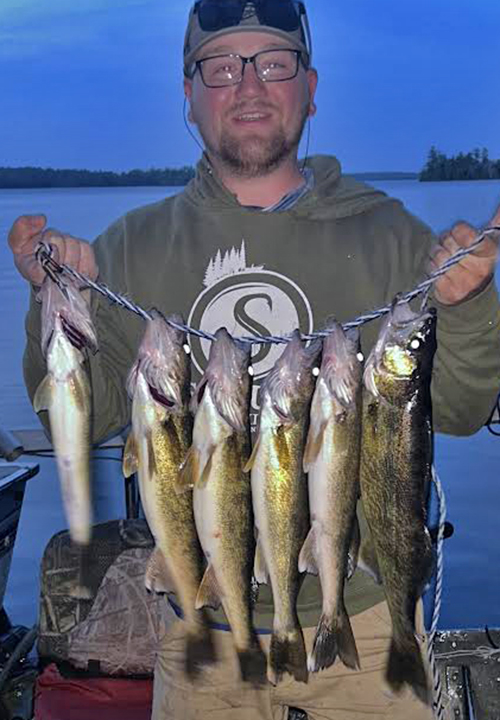 "Walleye opener was on the slow side for larger walleyes over 20 inches. Numbers of smaller males, some still milking, was a common report from anglers. As of Monday night, reports of big walleyes over 20 inches started coming in, so it seems the big females are recovering from the spawn and are looking to put some weight back on.
"Walleye opener was on the slow side for larger walleyes over 20 inches. Numbers of smaller males, some still milking, was a common report from anglers. As of Monday night, reports of big walleyes over 20 inches started coming in, so it seems the big females are recovering from the spawn and are looking to put some weight back on.
Anglers catching these big walleyes are saying a 1/4 ounce jig, tipped with big rainbows, pike suckers or lite northerns, is getting it done for them. River mouths and right off the dock have been the areas where this bite is happening. Why suckers? Suckers are spawning in the same rivers as the walleyes just did and walleyes are looking for an easy meal. White, pink and gold were the colors to have and 10 to 15 feet of water.
Northern Pike anglers reported some good pike fishing this last weekend. Large suckers, fished under a large bobber, was the ticket for catching some huge pike. Traditional spring pike locations like river mouths, large shallow bays and right off the end of the dock were all excellent places to catch big pike.
Crappies With a week's worth of bright sun and calm winds, reports of anglers finding a good crappie bite started coming into the bait shop. Anglers have been finding nice crappies back in shallow bays, in the pencil reeds, during the evening hours. Warm water has been the key to catching crappies, so the shallow lakes in the area have been producing best for anglers. Hair jigs or small tubes, fished under a bobber have been the ticket here.
Smallmouth Bass - Smallies started showing up for anglers right away this year. Large shallow rocky flats have been the area to focus on for smallies. With water temps in the low 50 degree range at best right now, fishing slow has been the key to catching these smallies. Suspending jerk baits fished as slow as you can has been very effective for smallies. Another key is to fish later in the day after the water temps have had a chance to hit their peak for the day.
Stream Trout Reports were limited this last weekend as many angler's focused on walleyes. The few stream trout reports we got were all on the positive side. Anglers mainly caught rainbows while fishing with a slip bobber and a night crawler suspended about 5 ft under the surface. Small handful of anglers targeted brook trout with small silver and blue spoons, casting along shorelines with good success.
Lake Trout reports were even more limited than stream trout. Few reports were from anglers that had limited success trolling deep diving crankbaits in 20-40 feet of water over deep mudflats." — Arrowhead Outdoors, 218-365-5358
 May 13, 2025 "Walleye Dead Zones: Studying the Study-Able"
May 13, 2025 "Walleye Dead Zones: Studying the Study-Able"
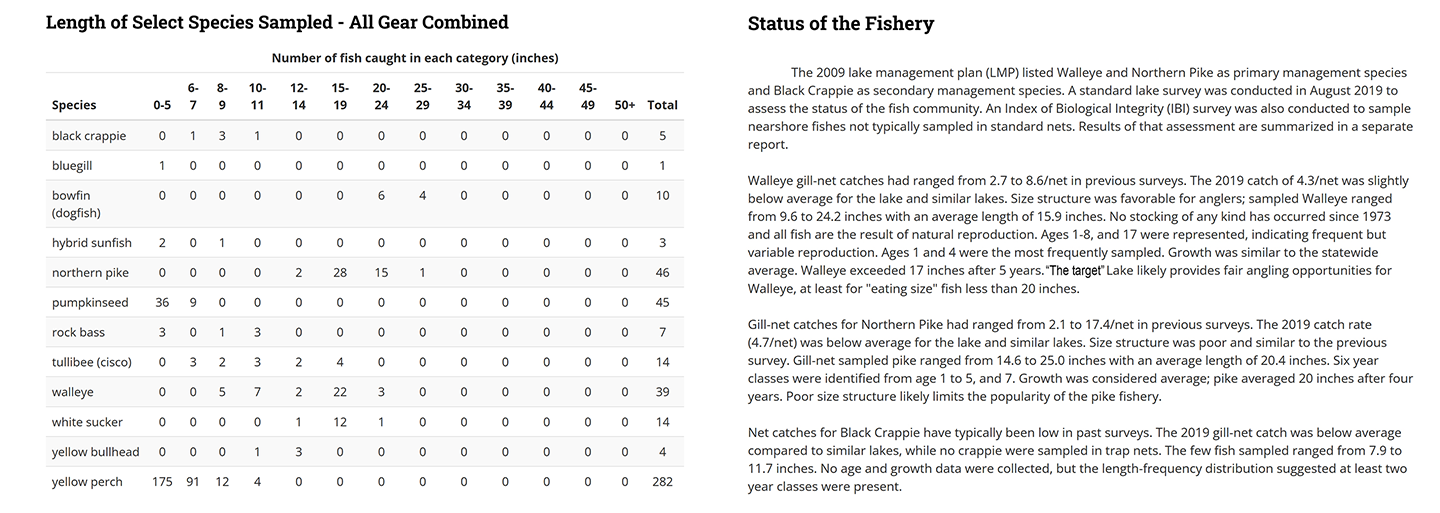 Frequent readers already know that I am equally enthusiastic about reporting my disappointments as my successes. Monday, I mentioned that I was headed toward a new lake to check for walleyes. I promised too that I’d share a report about the investigation, and the report is that the plan did not come together, but that’s okay. I think it was just a case of bad timing, but to be sure, I’ll wait a few weeks and then try the same lake again. In the meantime, I’ve decided to include you in the study process.
Frequent readers already know that I am equally enthusiastic about reporting my disappointments as my successes. Monday, I mentioned that I was headed toward a new lake to check for walleyes. I promised too that I’d share a report about the investigation, and the report is that the plan did not come together, but that’s okay. I think it was just a case of bad timing, but to be sure, I’ll wait a few weeks and then try the same lake again. In the meantime, I’ve decided to include you in the study process.
The accompanying image shows results of the most recent lake survey by MN DNR Fisheries. The “Status of the Fishery” report, combined with the “Length of Fish Sampled” chart, tend to become outdated quickly. So, it’s not realistic to expect the numbers from 6 years ago to match the lake’s current fish populations. That said, these reports do provide a glimpse into whether my target species exist in each lake, or not.
My expectations for the target lake were not wildly optimistic. When I compared the fishery status report to the fish sampled chart, I did see numbers good enough to make me believe that chances of catching at least some walleyes were reasonable. Crappies, while not the target species, may also be present to provide a “backup plan”.
The lake, around 500 acres, has some structure, but not an overwhelming amount. There are a couple of deep holes, lots of shallow flats and most of them have bulrushes to provide shallow cover. Most of the lake’s submerged weeds are “summer species”, like milfoil and pondweed varieties that disappear during winter, and grow back during mid-summer.
On Monday, surface water temperatures were cold, and ranged between 55 and 58 degrees. There were almost no weeds growing anywhere, and any vegetation we pulled off the bottom were dark, and decomposed. Bulrushes on the shallow flats were also dark and decomposed, showing no sign of new green shoots under the surface.
Because of the small size of the lake, I was able to cruise the entire shoreline, stopping to fish whenever I spied interesting spots on my graph. Every fish we caught along the shoreline were cookie cutter size northern pike, 18-to-19-inch fish. When I moved deeper over the breakline, 12 to 18 feet of water, we caught more cookie cutter size northern pike, 18-to-19-inch fish. There were no other strikes, or suspicious enconters along the shoreline.
When I moved out deeper and scanned water in the 18-to-26-foot range, I saw nothing. Not even the odd single, or school of small perch that “should have”, according to the reports, been out there somewhere.
Okay, so if the walleyes and crappies were not on the shoreline, and I couldn’t see them in deeper water, then where were they? I have theories of my own, but I’m curious to hear from you. Have you encountered a situation like this and “figured it out”? If so, let us know how you did it, and what you think I should have done differently. I’ll use your comments and suggestions to keep the discussion going. ![]() — Jeff Sundin, The Early Bird Fishing Guide Office Cell Call or Text 218-245-9858 or Email on Facebook on X
— Jeff Sundin, The Early Bird Fishing Guide Office Cell Call or Text 218-245-9858 or Email on Facebook on X
 May 12, 2025 Minnesota Walleye Report: "Opening the Open-Able"
May 12, 2025 Minnesota Walleye Report: "Opening the Open-Able"
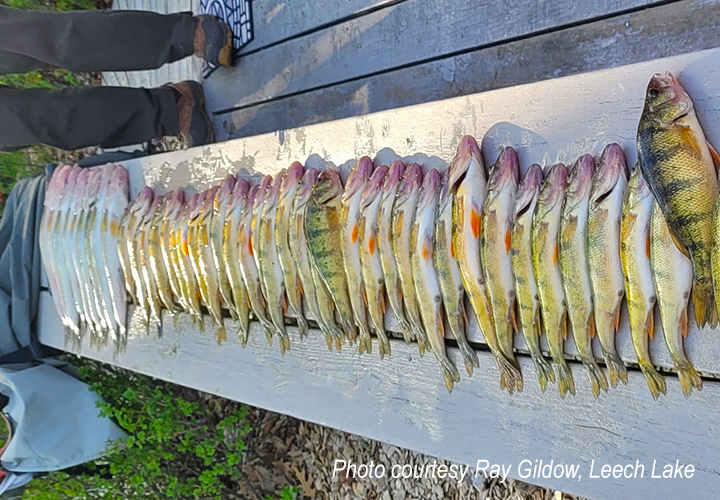 The warm and sunny weather for Minnesota’s walleye fishing opener was about as nice as it ever gets. Windy conditions were the only drawback, and then, only presented issues for anglers on the windy sides of the largest lakes. Most folks figured out spots where they could fish effectively.
The warm and sunny weather for Minnesota’s walleye fishing opener was about as nice as it ever gets. Windy conditions were the only drawback, and then, only presented issues for anglers on the windy sides of the largest lakes. Most folks figured out spots where they could fish effectively.
Fishing reports from the most popular walleye destinations were consistent with what we hear every year on the fishing opener. For most folks, catching less than the limits of walleyes was the norm. But for many, pike, perch or crappies came along in the mixed catch. Ray Gildow for example was on Leech Lake for the opener, and his crew caught a mix of nice walleyes and perch. Joe Billiar fished smaller waters in the Brainerd area and caught a mix of pike, crappies and walleyes.
Upper Red Lake was an exception, crowded for sure, but the walleye fishing was good. There were lots of folks reporting limit catches of walleye on both Saturday and Sunday. For some, reaching limits didn’t end their fishing trips, and catching and releasing walleyes was common. Most folks fished using jigs and minnows, but there were some reports of folks catching fish by trolling crankbaits too.
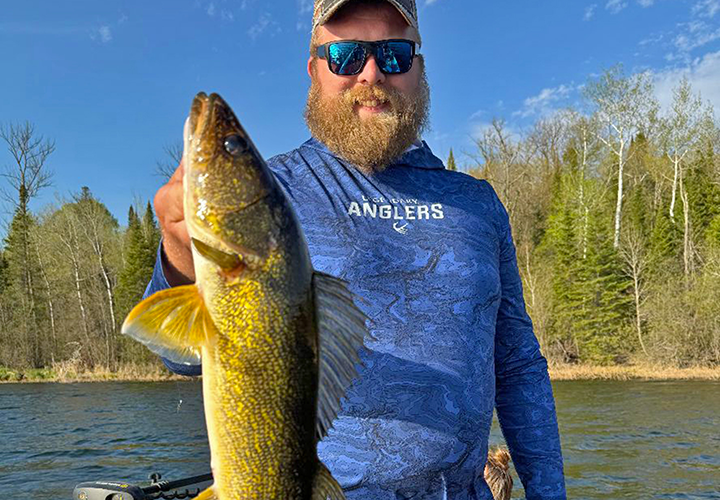 On Lake Winnibigoshish, most anglers caught walleyes, but reports of catching limits were further and fewer between than during the past few season openers. The season outlook posted last week by Bowen Lodge pointed to the reason. With about half of the strong, 2019 walleye year class now ranging in size from 18 to 19 inches, folks reported catching a mix of some keepers, along with some in the protected slot.
On Lake Winnibigoshish, most anglers caught walleyes, but reports of catching limits were further and fewer between than during the past few season openers. The season outlook posted last week by Bowen Lodge pointed to the reason. With about half of the strong, 2019 walleye year class now ranging in size from 18 to 19 inches, folks reported catching a mix of some keepers, along with some in the protected slot.
From Lake Winnie, Todd Martindale wrote; "Since you help with so much current information I would like to pass on my report from Saturday. We fished on Lake Winnibigoshish from 3pm to 8pm. Fished the river channel away from the crowd. 14 feet of water was the best depth for us. No fish on leeches, spottail shiners were best, but we also caught a few on plastics.
Color seemed to make a big difference. Gold was key for us. I was creeping along at .2 mph casting 1/8 oz jigs and when we caught one would spot lock. 3rd fish we hit a nice school and stay there for 3hr catching fish in waves. 3 of us ended with 13 keepers, smallest was 16 inches. Most of the walleyes we kept were in that 17 to 17.5 inch range. We also released 13 from 18 to 23.5 inches. Thanks again for all your reports, Todd Martindale.
For me and my family, the fishing opener weekend featured some fishing, some tree cutting, some Mother’s Day flowers and a lot of food! On the fishing front, we spent the afternoon on Saturday fishing a small lake, known for its mix of crappies, walleyes, pike and panfish. I was surprised that e didn’t catch any panfish and surprised too by the number of northern pike that were active. There were many times when we had more than on pike hooked up at the same time. That was good action for our granddaughter Audrey, and we harvested a few of them for the evening fish dinner at home.
I didn’t expect to catch a lot of walleyes, but I did expect to catch a few. Maybe it just took me too long to find “the spot”, or maybe they were not active during mid-day. Either way, the only potentially good walleye spot presented itself in the evening. On that spot, the Hippie Chick had a nice one hooked, but it escaped before we could get it in the boat. Austin, our son-in-law fared better, boating the nice walleye you see pictured here. Both fish were hooked using 1/8-ounce jigs tipped with spottails.
 By now it was 6:30 PM, and we planned to eat dinner before dark, so I drove away from the spot before assessing the walleye population there.
By now it was 6:30 PM, and we planned to eat dinner before dark, so I drove away from the spot before assessing the walleye population there.
For us, Sunday was all about family, and more specifically, Mother’s Day. The highlight was getting almost all the grandkids together. As you can see by the image of the Hippie Chick, 4 out of 5 is lap full, and plenty of reason to smile. The day, I think, was a success, but not much of it was spent worrying about fish, or fishing. That starts today, with the official start of my work season.
I see the tree tops waving again this morning, so instead of driving to any of the big lakes, I’m going to try an experiment. There are a handful of “new to me”, lakes that I’ve been studying over the winter and I’m thinking today is as good a time to try one of them as any. Whatever I learn will be new news, so I’ll plan on sharing the whole process with you tomorrow morning. ![]() — Jeff Sundin, The Early Bird Fishing Guide Office Cell Call or Text 218-245-9858 or Email on Facebook on X
— Jeff Sundin, The Early Bird Fishing Guide Office Cell Call or Text 218-245-9858 or Email on Facebook on X
 May 8, 2025 "Live Bait Transportation Protecting the Protect-Able"
May 8, 2025 "Live Bait Transportation Protecting the Protect-Able"
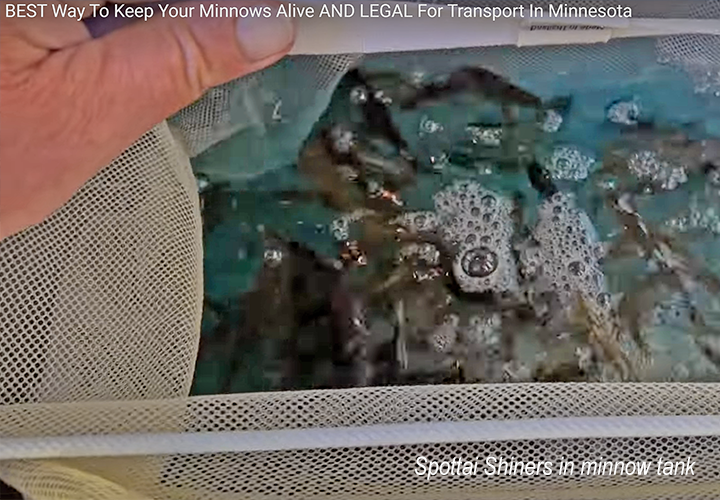 It’s official, we’ve already confirmed that live bait inventories at most retailers are in good shape for the Minnesota Walleye Fishing Opener. This is good news to be sure, but we know that in past seasons, the news hasn’t always been this good.
It’s official, we’ve already confirmed that live bait inventories at most retailers are in good shape for the Minnesota Walleye Fishing Opener. This is good news to be sure, but we know that in past seasons, the news hasn’t always been this good.
Just yesterday, I was called for an interview about all thing’s minnows in Minnesota. The interviewer, seeking to drill down into why minnows have become so hard to come by in the state, asked me to walk through some of the issues. I explained that it’s ironic that the subject comes up right now, just as bit dealers are sitting on good supplies. But I agree that this doesn’t mean there won’t be more shortages in our future.
Preventing the spread of invasive critters is no joke, and it’s why we got into this whole minnow supply pickle in the first place. The entire reason for being so protective about transporting live minnows is to prevent the introduction of invasives, and sadly, there are more of them than we realize.
Most everybody has heard about the most common invasives like zebra mussels, Eurasian milfoil, common carp and so on. Some folks even realize that less widely spread invasives like spiny water flea, faucet snails and rusty crawfish cause big problems too. A few have heard about a waterborne fish disease, VHS (Viral Hemorrhagic Septicemia) which isn’t found here yet, but it would be deadly to fish if it’s allowed into our waters.
That’s the “short list” and the problem is that there are dozens of other diseases and invasives that most Minnesotan’s have rarely, if ever, heard about. You can imagine that trying to protect the Minnesota lakes from all of them is a monumental task.
Some folks have asked questions like; “invasives are everywhere already, so why bother trying to stop them now.” The answer to that question is that nothing could be further from the truth. Less than 5% of Minnesota’s lakes are currently known to be infested with anything. Protecting the rest of them is worth working on, and it is the main reason why live bait must be transported carefully.
As the interview went on, we talked about how bait suppliers have adapted to regulations so far. I speculated too about some of the changes that will shape how Minnesota anglers will obtain live bait in the future. During our conversation, I reminded myself and advised the interviewer about several articles and videos that I’ve published already. The list below sheds light on a variety of concerns, and possible solutions, to minnow supply chain issues in the state.
- Feature Article: June 1, 2024 “How Can We Legally Transport Live Bait in Minnesota?”
- Video 3 Minutes: "BEST Way to Keep Your Minnows Alive AND LEGAL For Transport In Minnesota"
- Feature Article April 2, 2025: "Minnesota Minnows Growing the Grow-Able" Commercial Live Minnow Aquaculture
- "Minnesota AIS Legal System For Preserving My Precious Shiners and Live Bait Cargo" — Jeff Sundin May 20, 2022
- Video 11 Minutes: "Spottail Shiners Live Bait Trapping In Minnesota Waters"
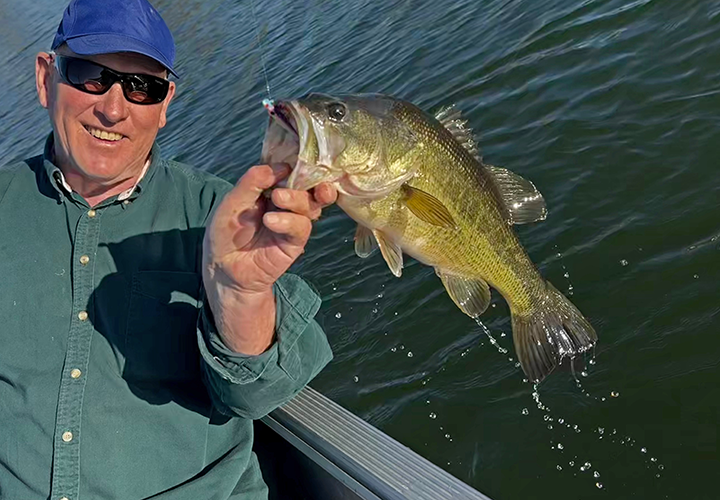 Being that many of us are only hours away from purchasing live bait for the fishing opener, I think reviewing this article, and accompanying video might be a good idea. The subject, how to legally transport live minnows both to and from the lake, can help you save big bucks this weekend, especially for folks who plan to move shiner minnows. Ranging between 8.99 and 11.99 per dozen, it won’t take long for the system I use to pay you back!
Being that many of us are only hours away from purchasing live bait for the fishing opener, I think reviewing this article, and accompanying video might be a good idea. The subject, how to legally transport live minnows both to and from the lake, can help you save big bucks this weekend, especially for folks who plan to move shiner minnows. Ranging between 8.99 and 11.99 per dozen, it won’t take long for the system I use to pay you back!
Before I wrap up for the morning, I should mention that I and the Hippie Chick ventured out on one of the Grand Rapids city lakes yesterday evening. Fishing wasn’t the main reason for launching the boat, but as long as we were making sure the boat is seaworthy, we did make a few casts.
Surface water on the small, stained water lake was 62 degrees, pretty warm for May 7th. I suspect a heavy chop on the surface would cut that temperature down a few degrees, and also that most of the larger lakes have not warmed that much so far. Despite warm surface temperatures, there weren’t any panfish roaming in the shallows. A few pike, and this bass, a rather nice example, did entertain us for a little while though.
Okay, by later today, a lot of folks will already be heading north, and I wish you safe travels. Tomorrow morning I’ll pop in with a few last-minute notes for the weekend and soon afterward, I’m joining the ranks as an official tourist for the opener. Remember, we love it when you share your stories, and this year, folks will be interested to hear about water conditions on the lake you fish. ![]() — Jeff Sundin, The Early Bird Fishing Guide Office Cell Call or Text 218-245-9858 or Email on Facebook on X
— Jeff Sundin, The Early Bird Fishing Guide Office Cell Call or Text 218-245-9858 or Email on Facebook on X
 Lake of the Woods, LOW Tourism May 7, 2025
Lake of the Woods, LOW Tourism May 7, 2025
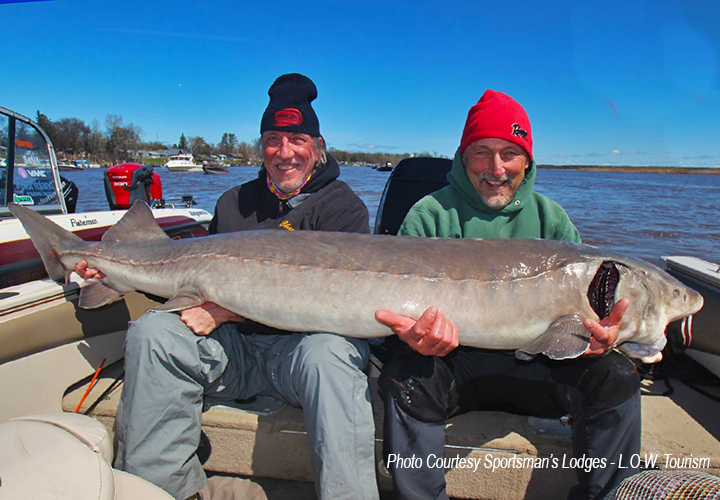 "A couple of tournaments this past weekend showed off some big fish from Lake of the Woods and Rainy River. The Annual Zippel Bay Resort Pike Tournament took place with good numbers of pike registered. A good number of pike tipped the tape at over 40 inches long.
"A couple of tournaments this past weekend showed off some big fish from Lake of the Woods and Rainy River. The Annual Zippel Bay Resort Pike Tournament took place with good numbers of pike registered. A good number of pike tipped the tape at over 40 inches long.
Sturgeon fishing is in full swing through May 15, 2026 on the Rainy River and the bite has been excellent. Anglers are catching good numbers of these prehistoric giants, and the Rainy River is one of the best places in North America to hook into one. There are sturgeon throughout the entire river. Four Mile Bay, at the mouth of the river has been holding good numbers of nice fish. Otherwise, most anglers are targeting holes up and down the river.
The annual Sportsman's Lodge Sturgeon Tournament took place with the winning sturgeon, a 78.25 inch monster taking the top spot. This, pending verification with the MN DNR, would be the new catch and release state record!
There is great news for folks planning to fish the south side of Lake of the Woods this weekend. The ice has finally disappeared, and although there may still be a few chunks floating around, the satellite view shows that the vast majority of the lake is wide open! A variety of webcams from around the lake also confirm that the lake should be clear for the Minnesota walleye fishing opener. What a great site to see!
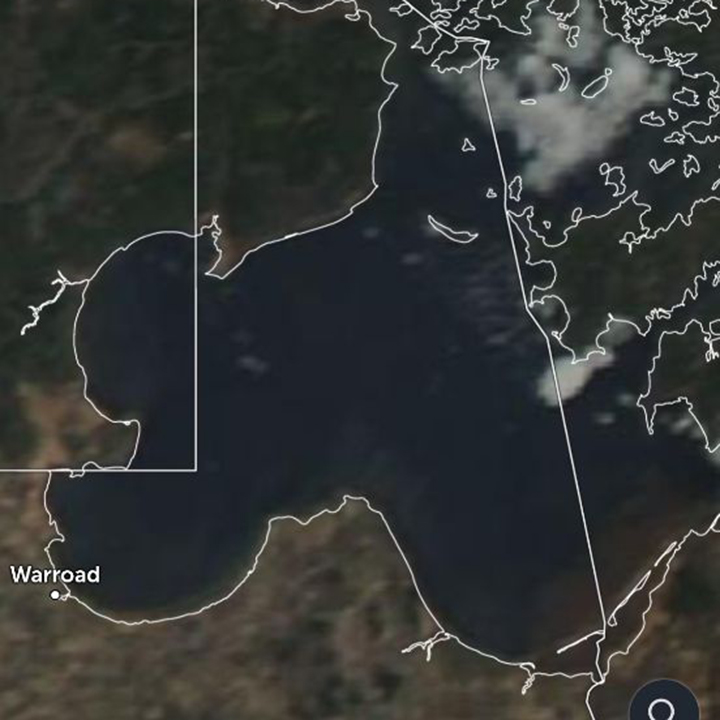 On the south shore, there will be lots of fishing opportunities for folks over the MN walleye fishing opener on Saturday. The outlook for walleye fishing is excellent. It is going to be an epic opener and there is still plenty of lodging available. Think about this...
On the south shore, there will be lots of fishing opportunities for folks over the MN walleye fishing opener on Saturday. The outlook for walleye fishing is excellent. It is going to be an epic opener and there is still plenty of lodging available. Think about this...
- The fish will be close to shore.
- The Rainy River and Four Mile Bay will still be holding fish
- It will be a jig bite
- A very strong population of walleyes and saugers in the lake
- Big females will be post spawn
On the May 10, 2025 opener, Lake of the Woods and the Rainy River enjoy a combined limit of walleyes and saugers of 6, with up to 4 being walleyes. The protected slot is 19.5 to 28.0 inches, those fish must be released. Anglers are allowed to have one walleye over 28 inches in possession.
With the late ice out, there will be plenty of walleyes, and some big walleyes, in the river for the opener. A jig and minnow will be the ticket for most. Some may still use a jig and larger plastic as many do during the spring walleye season. Whatever you decide to use, there will be some good action to be had.
Up at the Northwest Angle, there is open water and we have had some days in the 80's as well as some wind and that really took care of the ice just in time.
Traditionally, the fish will be near shore and on shoreline structure like points and neckdown areas. With the many islands in this area, there is a lot of structure and a lot of spots to fish. Just like the south end, it will be a jig bite this weekend for the walleyes. Given the strong ice fishing season and healthy lake conditions, expectations for good walleye catches are good up at the Angle and across the lake." — Lake of the Woods Tourism, (800) 382-FISH
 May 6, 2025 "Good News Begets More Good News: Live Bait Evening Update"
May 6, 2025 "Good News Begets More Good News: Live Bait Evening Update"
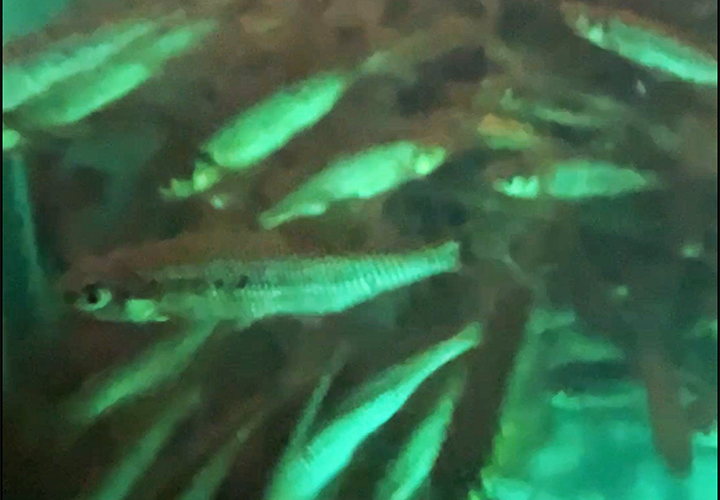 Sometimes good news begets more good news and today, that’s what’s happening. Sunshine, summer-like temperatures and relatively calm seas are encouraging spottail shiners to move onto shallow water sand flats. The good conditions are allowing minnow trappers easy access, and bait tanks are filling up at the retailers.
Sometimes good news begets more good news and today, that’s what’s happening. Sunshine, summer-like temperatures and relatively calm seas are encouraging spottail shiners to move onto shallow water sand flats. The good conditions are allowing minnow trappers easy access, and bait tanks are filling up at the retailers.
Northwoods Bait in Bemidji reported earlier that they are ready to rock and roll with all the spottails they’ll need for the fishing opener. Ditto that report at River Rat Bait in Cohasset, Lisa reports plenty of shiners in inventory to last through the upcoming weekend. Here in Grand Rapids, I visited with Brent Haugen who filled in on the L&M Supply stores live bait supplies. For the 4 stores that have live minnow tanks, Bemidji, Detroit Lakes, Virginia and Grand Rapids stores, shiner minnows are in good supply.
Word on the street is that leech trappers in the region struggled early, and some stores may be short on them this weekend. But the warm temperatures are improving leech trapping too, so any shortage will be short-lived. Night crawlers, along with other minnow varieties are in stock at all of the retailers I checked with as well.
Okay, so I guess we can quit worrying about minnows, for this weekend anyway. Like I mentioned this morning, let us know what you learn at your favorite bait shop. Tomorrow morning, I’ll drop in any last-minute notes that might be helpful over the weekend. ![]() — Jeff Sundin, The Early Bird Fishing Guide Office Cell Call or Text 218-245-9858 or Email on Facebook on X
— Jeff Sundin, The Early Bird Fishing Guide Office Cell Call or Text 218-245-9858 or Email on Facebook on X
 May 6, 2025 "2025 Walleye Fishing Opener: Supplying the Supply-Able"
May 6, 2025 "2025 Walleye Fishing Opener: Supplying the Supply-Able"
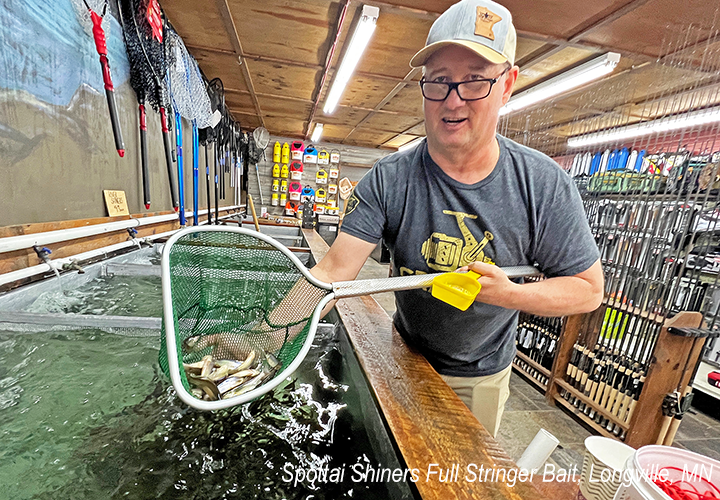 It’s been a long time since I’ve shared good news about minnow supplies for the Minnesota walleye fishing opener. But after a quick stop to Full Stringer Bait in Longville, (photo left) it appears that this year I can. Spottail shiners, at least at this store, are already in the tanks and according to Troy, they have plenty of minnows to please customers who want them this weekend. The price, $9.95 per dozen, remains high, but at least hasn’t increased from 2024 pricing.
It’s been a long time since I’ve shared good news about minnow supplies for the Minnesota walleye fishing opener. But after a quick stop to Full Stringer Bait in Longville, (photo left) it appears that this year I can. Spottail shiners, at least at this store, are already in the tanks and according to Troy, they have plenty of minnows to please customers who want them this weekend. The price, $9.95 per dozen, remains high, but at least hasn’t increased from 2024 pricing.
Gerry Albert, retired MN Large Lake Specialist checked the shoreline at Winnibigoshish yesterday. “The spottails are in, and they’re thick”, Albert told me on the phone. Neither of us knows for sure how the live bait trappers are faring at catching them, but this potentially, this is excellent news! And for sure, it gives me a story to chase down today, and I will.
The fishing opener is always a hectic time. Lines are long, patience is at a premium and let’s face it, these days, manners are sometimes lacking. Do yourself, and your fellow anglers a huge favor and buy your fishing license right now. If you can read this report, then you can click on this link to >> Buy Minnesota Fishing License Online.
The last thing I need is to get caught out of position without my fishing license. So, every year, I print several copies of mine, and I keep one paper copy in the boat, one in my wallet, and one in my truck. Then, I save one copy on my phone. Wherever I am, I am covered and protected from getting a ticket for an embarrassing and completely avoidable violation.
Speaking of avoidable violations, did you read the article “Don’t Land a Citation, Avoid Embarrassing and Costly Fishing Violations” last week? If you didn’t, check it out today because there are tips in it, along with a checklist that will help you steer clear of the most common fishing and boating violations.
Okay, back to bait supplies for a moment. Ordinarily, I would hold off on sharing another report until Wednesday morning. But today, I'll work up another live bait update for later this afternoon.
I can only cover so much territory, and there are lots of great bait and tackle shops in Minnesota. So, I need your help! Let me know about the one store that you can always count on, the bait shop that has what you need, and always treats you right. Let me and your fellow anglers too, if you already paid them a visit, and what their predictions are for bait supplies this coming weekend. ![]() — Jeff Sundin, The Early Bird Fishing Guide Office Cell Call or Text 218-245-9858 or Email on Facebook on X
— Jeff Sundin, The Early Bird Fishing Guide Office Cell Call or Text 218-245-9858 or Email on Facebook on X
Fishing Destination | Brainerd, Grand Rapids, Lake Winnie Area | Joe Billiar, Crooked Hat Guide Service
 Jeff Sundin May 5, 2025 "Preparing For The MN Fishing Opener" | Joe Billiar, Crooked Hat Guide Service
Jeff Sundin May 5, 2025 "Preparing For The MN Fishing Opener" | Joe Billiar, Crooked Hat Guide Service
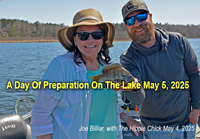 In north central Minnesota, the weather turned warm on Sunday, the breezes calmed down, and the stage was set for a beautiful day of preparation. Folks were out on lakes in the region, some fishing, others testing their boats, some just enjoyning the day.
In north central Minnesota, the weather turned warm on Sunday, the breezes calmed down, and the stage was set for a beautiful day of preparation. Folks were out on lakes in the region, some fishing, others testing their boats, some just enjoyning the day.
For I and the Hippie Chick, that day of preparation came in the form of a pre-fish trip with Joe Billiar on a Hackensack area lake. Billiar, “Crooked Hat Guide Service”, is a frequent contributor of fishing reports from the Brainerd, Lake Winnie, and other north central Minnesota lakes.
Billiar is among the trusted few fishing guides on “Sundin’s Short List of Guides”. He often lends a helping arm when customers request dates when I ..." Read >> May 5, 2025 "Preparing For The MN Fishing Opener" | Joe Billiar, Crooked Hat Guide Service
 Cutfoot Sioux, Lake Winnibigoshish 2025 Fishing Season Outlook May 4, 2025
Cutfoot Sioux, Lake Winnibigoshish 2025 Fishing Season Outlook May 4, 2025
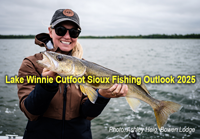 "Survey data from MN DNR 2024 Fisheries assessments are in, and this week, Dan Schermerhorn, the large lake specialist for the MN DNR Grand Rapids, MN region, shared his insights into lake data for the Winnie-Cutfoot chain of lakes and flowages.
"Survey data from MN DNR 2024 Fisheries assessments are in, and this week, Dan Schermerhorn, the large lake specialist for the MN DNR Grand Rapids, MN region, shared his insights into lake data for the Winnie-Cutfoot chain of lakes and flowages.
Walleye anglers will most likely notice a change in the average size of the fish they catch this season. Walleyes from the strong, 2019-year class remain plentiful, and have grown! After analyzing 2024 data, Schermerhorn estimates that the average length of female walleyes will be about 19 inches during spring. Their 2019 male counterparts should measure somewhere between 17-1/2 and 18 inches on opening day.
In 2024, our guests, fishing guides and friends who fish Winnie a lot, reported catching fish from other year classes too. The strong, 2018-year class remains well represented, and there were numerous fish in the 20-to-22-inch size range caught last summer and fall. Those larger, 2018 fish, combined with females from the 2019-year class will offer anglers the opportunity to ..." Read >> Bowen Lodge Cutfoot Sioux, Lake Winnibigoshish 2025 Fishing Season Outlook May 4, 2025
 Wired2Fish May 4, 2025 "How To Beat Tariff-Driven Fishing Lure Price Hikes"
Wired2Fish May 4, 2025 "How To Beat Tariff-Driven Fishing Lure Price Hikes"
 "This is not an opinion piece on President Trump and his policies. I am not here to take a political stance. I did not sign up to report on international trade. But, love them or hate them, many of us are starting to feel the effects of the highly debated tariffs that have been implemented on international goods—those coming from China in particular.
"This is not an opinion piece on President Trump and his policies. I am not here to take a political stance. I did not sign up to report on international trade. But, love them or hate them, many of us are starting to feel the effects of the highly debated tariffs that have been implemented on international goods—those coming from China in particular.
A lot of products in the bass fishing market are obviously produced in China. At the time of writing this, there’s a 145% tariff on these products. Just doing quick math, to maintain the same profit margin percentage-wise, I believe that puts a $5 crankbait at around $12.25.
Now, we haven’t seen any price hikes quite that dramatic yet, but the prices are certainly creeping up as companies try to soften the blow for their consumers while simultaneously protecting their bottom lines as best they can, with no certainty of how long the tariffs and price hikes will last. There’s a tendency to think, “We’ll just ..." Read Article and Learn More >> ..." Read Article and Learn More >> How To Beat Tariff-Driven Fishing Lure Price Hikes
 May 2, 2025 "Minnesota Walleye: Is Limiting the Limit-Able, Needed and Reasonable?"
May 2, 2025 "Minnesota Walleye: Is Limiting the Limit-Able, Needed and Reasonable?"
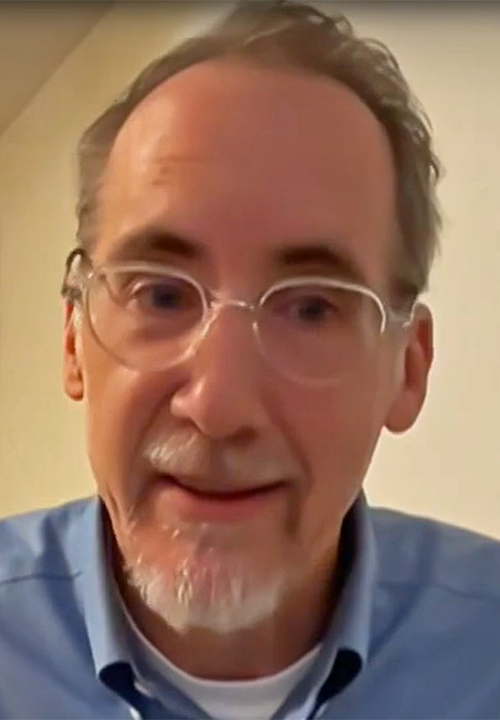 Word on the street is that a Minnesota DNR rule to cut walleye possession limits is soon to be released. Ahead of the supposedly pending announcement, folks on both sides of the issue have been active, debating the pros and cons. For me, and many FishRapper readers, most of the discussion is “old news”. That’s because the debate has already been going on for about 8 years, in fact my first article on the subject appeared in 2017.
Word on the street is that a Minnesota DNR rule to cut walleye possession limits is soon to be released. Ahead of the supposedly pending announcement, folks on both sides of the issue have been active, debating the pros and cons. For me, and many FishRapper readers, most of the discussion is “old news”. That’s because the debate has already been going on for about 8 years, in fact my first article on the subject appeared in 2017.
In search of folks who can offer a fresh perspective on the topic, I’ve reached out to writers, angler associations, fisheries biologists and to the public. One of the more successful efforts came in the form of “reader response” to the poll offering FishRapper readers who support the proposal. Early Monday morning, I shared the results of that poll aimed at gauging expectations among those supporters of that proposal. If you haven’t read the results yet, you can find the full story here >> Reader Poll Invitation April 22, 2025 "Walleye Limit Reduction: Supporters Poll"
At the time I offered the poll, I asked for input from scientists, biologists and fisheries manager who support the rule change. My hope was to provide you with some “scientific evidence” that dropping the walleye limit would produce the desired results. While the response to my reader poll offer was good, the offer to provide a platform to “pro rule change” scientists fell on deaf ears. The response to that plea for information was zero, 0%.
On the other hand, there was plenty of response from scientists who do not favor the rule change. Some of those researchers plan to come out with their own response to the rules proposal when it’s announced. Others shared their thoughts but preferred not to go on record and still others have offered opinions which will appear in articles as I get their stories written.
Today, I’ll share the thoughts of one such expert, Paul Radomski, author of the book “Walleye: A Beautiful Fish of the Dark.” In case you don’t already know him, listen to this KAXE radio interview. “Minnesota writer Paul Radomski Book Unspools Mysteries of the Walleye”, you’ll find a link to the interview just below the story title on the station’s web page.
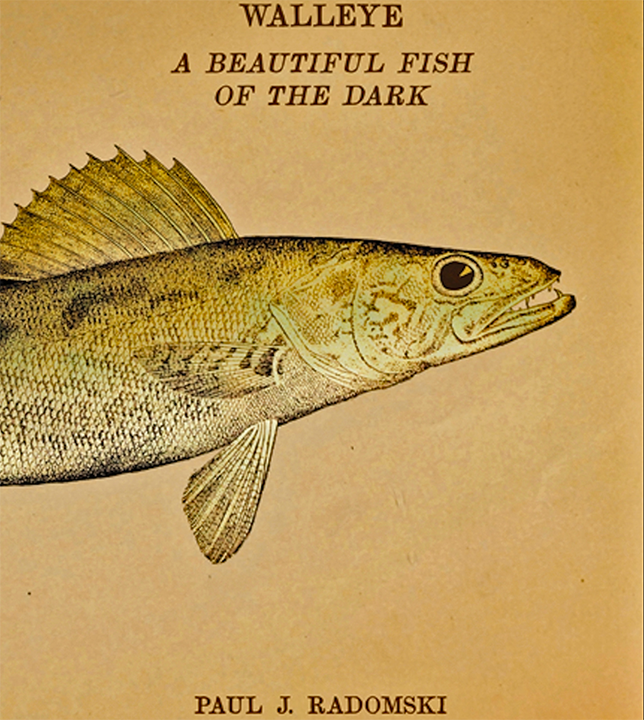 Q) Sundin, “Attempting to make sense of the debate about the MN DNR effort to reduce the walleye possession limit. I’ve reached out to and received replies from several DNR biologists. Most of them are presenting data in opposition to the walleye limit reduction. Are you aware of any recent papers that offer fact-based information in support of reducing walleye limits?”
Q) Sundin, “Attempting to make sense of the debate about the MN DNR effort to reduce the walleye possession limit. I’ve reached out to and received replies from several DNR biologists. Most of them are presenting data in opposition to the walleye limit reduction. Are you aware of any recent papers that offer fact-based information in support of reducing walleye limits?”
A) Radomski, “Recently, a lot of anglers have asked my opinion on this matter. Here is my common response.
There are no recent papers supporting reducing the MN statewide walleye creel limit. There remain a few unanswered questions about the walleye creel limits; however, creel statistics for walleye angling have shown a consistent pattern — only about 1% of walleye angling trips result in a limit of 6 fish.
Q) Sundin, “Over the years, fisheries biologists have suggested that a 4-walleye limit will not impact the overall walleye harvest. They’ve reported consistently that to have an impact on the overall walleye harvest, a 2 fish limit would be required, is that right?
A) Radomski, “It is interesting that many people don't understand creel limits. How effective any creel limit reduction for conservation depends on the species, harvest rates, magnitude of the existing limit, and magnitude of the limit change.”
“Often, anglers make the case for creel limit reduction based on “common sense”, but they don't do the math, and they make incorrect assumptions. However, fiddling with creel limits gives commissioners and angling leaders “bragging rights” that they did something. But was the change meaningful?”
Radomski offers that in certain cases, a creel limit reduction can be a reasonable solution to address overfishing. In 2000 for example, Radomski worked with a small team to change the creel limits for yellow perch. At the time, the previous limit of 100 fish in possession was lowered to 20 fish daily, with a 40 fish possession limit.
“I supported that change by showing the need (On Winnie) where large perch, over 9 inches, had declined since 1977, while growth and survival of small perch increased.” Radomski says. “Overfishing Recruitment Response” is the term Radomski used to describe the trouble; he also reported that condition of large perch had decreased as well.
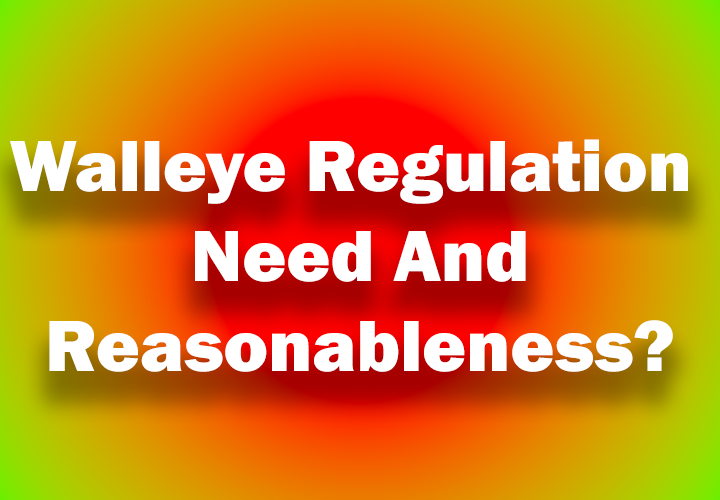 Radomski’s team made predictions to estimate the probability that various perch creel limits would achieve necessary harvest reductions. The team concluded that there was a need, and that the proposed perch creel limit reduction was reasonable. Radomski recalls that the DNR Commissioner at the time took some criticism for that change.
Radomski’s team made predictions to estimate the probability that various perch creel limits would achieve necessary harvest reductions. The team concluded that there was a need, and that the proposed perch creel limit reduction was reasonable. Radomski recalls that the DNR Commissioner at the time took some criticism for that change.
Fisheries biologist and lake ecology scientist Radomski was also involved in the statewide review of fish creel limits and suggested reductions in the lake trout creel limit, and more recently, the reduced burbot creel limit of 4 fish aimed at reducing wanton waste. He recalls these changes, based on need and reasonableness being easier to achieve.
Radomski, “To summarize what is known, creel limits do not directly control or limit the total harvest. Creel limits regulate the individual or the party, not the collective. I also stated that creel limit reductions were likely insufficient to reduce harvest and at best only provide temporary fisheries results.”
To learn more about the impact of creel limits, Randomski encourages read the chapter on walleye management in his aforementioned book >> Walleye: A Beautiful Fish of the Dark .
In it, Radomski quoted other biologists that state it is rare that creel limits reductions make a difference. While creel limits do not directly control total harvest, fisheries managers often reduce limits for some waters to shift angling effort to other waters, as some anglers will avoid waters with low creel limits.
Radomski, “Anglers view the reduced walleye creel limits for Minnesota's important large walleye lakes and conclude that other walleye lakes would benefit with lower creel limits. However, the purpose for those lower walleye creel limits (excluding Mille Lacs and Red Lake) was a result of angler and community conversations, and the need and reasonableness of those changes generally were not supported with biological data. Rather, walleye creel limits for these waters were based an ethical argument or for the purpose of distributing the harvest (social issues).”
“I've heard state of MN officials argue for a creel limit reduction to conserve walleye. Yet, I've not heard about any recent estimates of how Minnesota's proposed creel limit change from 6 to 4 is going to provide meaningful conservation results, nor have I seen estimates of how many walleye will be conserved or saved with such a change.” Radomski said.
He acknowledges that it is commonly understood that walleyes are being impacted by a changing climate, angling technology, and habitat loss. But believes that the reasons stated for the Minnesota's walleye creel limit change have lacked specifics. He argues that a statewide walleye creel limit reduction from 6 to 4 will not address nor mitigate these impacts. What is needed most, he believes, is agency and legislative action that is commensurate with the seriousness of these large and growing threats to Minnesota walleye.
Radomski speculates, “What would be a reasonable alternative to a statewide creel limit reduction?”
Answering his own question, Radomski offers, “A protected slot limit is a zero-creel limit for the protected sizes that can regulate the collective for a range of fish sizes in a fishery. For example, in Minnesota one could replace the 1 walleye over 20 inches creel limit. This 1-over regulation is indeed a creel limit – it is a creel limit on big fish. So, an alternative solution might be to replace an existing 1-over regulation with a creel limit of 0 for walleye between 20 to 24 inches (or the most suitable length range).” Replace the existing 1-over regulation with a big fish protected slot limit. If such a protected slot limit regulation would work for most walleye fisheries, then it seems reasonable to consider it as a potential alternative conservation solution.”
In some lakes, stockpiling large walleye creates other problems, and again Radomski suggests reading “walleye fisheries dynamics” chapter of his book to understand why. So, the question is whether a reduction from 1-fish over 20 inches to 0-fish between 20-24 inches would conserve enough fish to make a difference, yet not stockpile too many large fish?
Radomski, “I don't know the answer to the question I pose; however, I suspect that a statewide 20-24 protected slot limit would be more effective than the statewide 1-over 20 inches regulation and a statewide 6 to 4 creel limit reduction.”
“I don't know how many walleye waters would benefit from such a change, but fisheries biologists could simulate the change to assess its potential merits, or better yet they could apply such a regulation and see if it produces meaningful results.”
Radomski does not necessarily object to reducing the statewide walleye creel limit. But if he were able to advocate for the limit reduction, would only do so provided acceptance by a clear majority of the angling community.
In his opinion, the prime purpose of walleye creel limits these days is to regulate social issues. Fisheries managers reduce limits to send a message that the walleye are finite and to reduce greed when existing creel limits are perceived as too large. He would only make the case based on social acceptance.
Radomski concludes, “I believe fisheries managers must provide a honest assessment about the function and purpose of walleye creel limit reductions.” Paul J. Radomski, Author of Walleye: A Beautiful Fish of the Dark
In the coming days, I'll share more commentary from fisheries experts, and walleye fishing enthusiasts. As always, your comments and questions are both welcome and helpful, so don't be a shy! ![]() — Jeff Sundin, The Early Bird Fishing Guide Office Cell Call or Text 218-245-9858 or Email on Facebook on X
— Jeff Sundin, The Early Bird Fishing Guide Office Cell Call or Text 218-245-9858 or Email on Facebook on X
 May 1, 2025 "Don't Land A Citation! Avoid These Embarrasing and Sometimes Costly Fishing-Boating Violations"
May 1, 2025 "Don't Land A Citation! Avoid These Embarrasing and Sometimes Costly Fishing-Boating Violations"
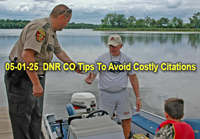 Every year, I’m amazed by the number of encounters I have with folks who commit innocent, but potentially expensive, fishing violations. Admittedly, many of the violations do not amount to anything like “crimes of the century”, but they can be both embarrasing, and costly. AND, if they’re serious enough to warrant a citation, then they’re serious enough for us to talk about here.
Every year, I’m amazed by the number of encounters I have with folks who commit innocent, but potentially expensive, fishing violations. Admittedly, many of the violations do not amount to anything like “crimes of the century”, but they can be both embarrasing, and costly. AND, if they’re serious enough to warrant a citation, then they’re serious enough for us to talk about here.
With the assistance of Minnesota DNR Enforcement, Lieutenant Colonel, Robert Gorecki, and Communications coordinator, Joe Albert, I put together a list of the more common offenses anglers make every year. To get assessments from varying geographic regions, Albert consulted with conservation offers (CO-s) from across Minnesota.
One caveat, the list I’m presenting does not cover every conceivable fishing violation, for that, you NEED to ..." Read Full Report >> May 1, 2025 "Avoid Embarrasing and Costly Fishing and Boating Violations"
KAXE Radio: With the ice out, walleye spawning is underway in Minnesota
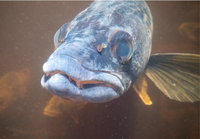 "In spring, eggs have been collected at Cut Foot Sioux walleye spawning site in Deer River, MN, since the 1920s. Fertilized eggs are transported throughout the state.
"In spring, eggs have been collected at Cut Foot Sioux walleye spawning site in Deer River, MN, since the 1920s. Fertilized eggs are transported throughout the state.
The fishing opener is fast approaching and Minnesota’s state fish — the walleye — no doubt will be a coveted catch for any angler.
First things first: walleye spawning season starts not long after ice out, when the waters begin warming into the mid-40s.
Recently, the Cut Foot Sioux walleye spawning site in Deer River, east of the Highway 46 bridge, was busy with walleyes, Grand Rapids Fish Hatchery workers and curious onlookers. The public is welcome to visit and watch the process. Instinct guides walleyes to ..." Learn More >> KAXE Radio: With the ice out, walleye spawning is underway in Minnesota
 May 1, 2025 "Reader Poll Gauges Support For MN DNR Walleye Limit Reduction Plan"
May 1, 2025 "Reader Poll Gauges Support For MN DNR Walleye Limit Reduction Plan"
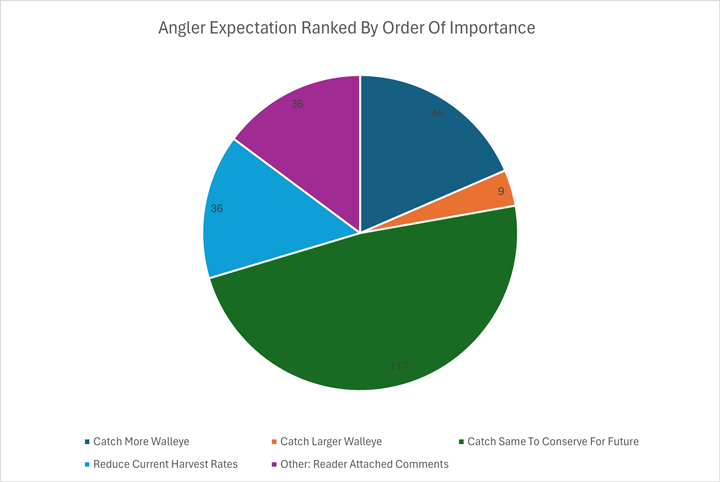 Over the past week, supporters of the MN DNR proposal to reduce Minnesota’s walleye possession provided their input. The sample size is not huge, but it is meaningful because readers who wanted to participate in the survey were required to jump through a few hoops to opine.
Over the past week, supporters of the MN DNR proposal to reduce Minnesota’s walleye possession provided their input. The sample size is not huge, but it is meaningful because readers who wanted to participate in the survey were required to jump through a few hoops to opine.
Unlike most click and submit surveys, participants were required to request the poll via email, complete the survey and then return their answers, again via email. The reader participation poll, while not a scientific one, does qualify as an above-average effort to gather meaningful insight into why supporters of the rule change believe that it will help. The response, I believe, exceeded my expectations. Most participants provided well-reasoned and thoughtful comments.
Responding to question 1, “Assuming that if a proposed statewide limit reduction from 6 walleye, down to 4 walleyes in possession passes, do you anticipate an improvement to the quality of walleye fishing in Minnesota?” As the chart, "Angler Expects Improved Walleye Fishing" upper left shows, 57% of the respondents said ..." Read Full Story >> May 1, 2025 "Reader Poll Gauges Support For MN DNR Walleye Limit Reduction Plan"
 Wired2Fish May 1, 2025 "The Biggest Bass Bags of All Time"
Wired2Fish May 1, 2025 "The Biggest Bass Bags of All Time"
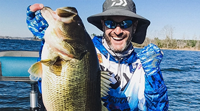 "They say that records are meant to be broken. But in professional bass fishing, there are a few that are considered almost untouchable.
"They say that records are meant to be broken. But in professional bass fishing, there are a few that are considered almost untouchable.
You don’t hear Rip Nunnery, a California fisherman, mentioned in the same breath as Rick Clunn, Kevin VanDam or Roland Martin. Still, what he accomplished in July 1969 will probably never be matched.
Fishing in a B.A.S.S. tournament on Alabama’s Lake Eufaula, he brought in a stringer of bass so heavy that he needed help bringing it to the scales. In the days when a 15-bass daily limit was in place, he weighed in a first-round total of 98 pounds, 15 ounces. That set a B.A.S.S. record for largest one-day ..." Read Article and Learn More >> The Biggest Bass Bags of All Time
 Wired2Fish April 29, 2025 "Power Fishing Walleyes With Moving Baits on Big Water"
Wired2Fish April 29, 2025 "Power Fishing Walleyes With Moving Baits on Big Water"
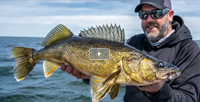 "Pro bass angler and multi-species guide, Adam Rasmussen, heads out on sprawling Green Bay to target scatted spring walleyes using moving baits. Top spring walleye baits such as jerkbaits and paddle tail swimbaits allow you to cover water fast and trigger aggressive reaction bites.
"Pro bass angler and multi-species guide, Adam Rasmussen, heads out on sprawling Green Bay to target scatted spring walleyes using moving baits. Top spring walleye baits such as jerkbaits and paddle tail swimbaits allow you to cover water fast and trigger aggressive reaction bites.
Fishing Post-spawn Walleye In Cold Water: Following the spawn, walleyes often hang around warmer, shallow waters to recuperate and feed.
Rasmussen targets 6- to 8 feet of water, where the fish are most active. Despite the cold temperatures, these fish still respond aggressively to reaction baits like jerkbaits, blade baits, and paddle-tails. Rasmussen explains how aggressive presentations used in conjunction with fish finder tech such as ..." View Video and Learn More >> Power Fishing Walleyes With Moving Baits on Big Water
You Are Invited To Become A Duly Deputized Fishrapper Cub Reporter Too!
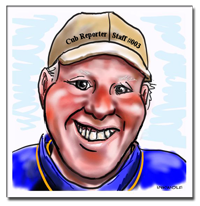 If you've been waiting for a gold engraved invitation to participate in the daily reports, then stop waiting and consider this your own personal invitation.
If you've been waiting for a gold engraved invitation to participate in the daily reports, then stop waiting and consider this your own personal invitation.
Helping your fellow fishermen and women stay abreast of fishing conditions in your area is good for everybody and it's easier than you think! You don't have to write a book, you don't have to share your secret fishing spots and you don't even have to mention your lake. But even a few words about general trends, seasonal patterns and local weather conditions can really help.
Be like me, become a duly deputized "Cub Reporter", it's good for fishing! Contact Us or if you prefer to be "social", Fishing Reports Minnesota, the Facebook counterpart to this page is open to the public, so you can post your own fishing update or just share a photo of a nice catch.